The Maldives is racing to create new land. Why are so many people concerned?
By Jesse Chase-Lubitz
Photography by Neeta Satam for Nature
24 April 2024


The island nation is expanding its territory by dredging up sediment from the ocean floor.
But scientists, former government officials and activists say such reclamation can harm marine ecosystems and make the country more vulnerable to rising seas..
This article was produced in partnership with the Pulitzer Center.
This article is also available as a pdf version.
“Sun, sand and sea.” Those are the three ingredients for tourism in the Maldives, Mohamed Shaiz’s father told him. For more than a decade, Shaiz’s family owned a successful local hotel in Addu, the Maldives’ southernmost atoll. But nearly 9 months ago, the government took away the sea.
A state-sponsored project had pulled up sediment from offshore areas and used it to extend the beach in front of the hotel by 130 metres — too far to walk for most tourists who want easy access to the ocean. Now all Shaiz sees from his hotel is a human-made desert and a slew of cancelled reservations.

The view in front of Mohamed Shaiz’s hotel on Addu Atoll.
The Maldives is an 820-kilometre-long chain of nearly 1,200 islands dotting the Indian Ocean. The nation has become one of the most popular luxury tourism destinations in the world because of its Instagrammable beaches and its advertising slogan: “the sunny side of life”. But the Maldives is also one of the countries most vulnerable to sea-level rise . With 80% of its land less than one metre above sea level, some scientists predict that the islands could be completely submerged by 2100.
In an effort to keep the country above water and thriving, the government is adopting a strategy used by many nations around the globe : land reclamation. The sandy stretch in front of Shaiz’s hotel is some of the newest land on the planet, dug up from the bottom of the ocean, sucked through pipes and piled along the coast to make more space.
Maldivian government officials say that the land is necessary to make room for economic development, especially as sea levels rise.
“This will be a doorstep, a job destination and an income-generating destination,” said President Mohamed Muizzu at the inauguration of a new land-reclamation project last December.
Critics are unconvinced, and say that the country has enough space to thrive. One swathe of land on a neighbouring island near Shaiz’s hotel was reclaimed in 2016. It remains undeveloped today. “Call me in five years,” Shaiz says, gesturing to the newly created desert in front of his hotel. “This land will be the same.”

Mohamed Shaiz and his family own a hotel on Addu Atoll.
In addition to the disputed economics, there is serious concern about the environmental damage that land reclamation can cause. Studies in the Maldives and at other sites around the world have shown that it can harm corals and seagrass, damage natural barriers, such as sand bars, mangroves and estuaries, and destroy marine habitats. “Atolls are extremely vulnerable ecosystems,” says Bregje van Wesenbeeck, the scientific director of Deltares, a Dutch research institute for water management in Delft. “Once you start to interfere with them, you’re sort of failing them.”
Expanding territories

The island of Gulhifalhu lies just west of the capital, Malé. A reclamation project started in 2020 is filling in half the atoll.
Dutch planners are often considered the founders of land reclamation, with a history of water engineering going back some 800 years. Over the centuries, land-forming projects have shaped some of the world’s major cities, including Singapore, London, New York and Miami. In recent decades, most of the reclaimed land has been in East Asia. In China, Shanghai has reclaimed 350 square kilometres — more than three times the size of Paris — over the past few decades. Colombo has added 100 km 2 in just 4 years, and 65 km 2 of Mumbai is reclaimed. A study on twenty-first-century coastal-land reclamation found that of 135 large coastal cities with populations of more than one million people, 75% had reclaimed land 1 .
With projects stretching back to 1997, the Maldives is a veteran of large-scale land reclamation. Then-minister of state for environment Abdulla Naseer said in 2018 that there are an estimated 50 islands with reclaimed land in the country, although many specialists say that’s a conservative estimate.

Source: Maldives Land and Survey Authority
Land scarcity is a key factor driving reclamation projects. Although the nation’s territory covers 90,000 km 2 , more than 99% of it is ocean. Around half a million people live on a total land area of just 300 km 2 , and the country welcomes around 1.3 million tourists each year, who contribute 80% of its gross domestic product. The capital, Malé, is one of the most densely populated parts of the planet. It’s possible to walk across the entire island in 20 minutes.

Images captured by LANDSAT satellites in 1997 and 2020 show the impact of reclamation projects on Malé and nearby islands.
Credit: Lauren Dauphin/NASA Earth Observatory
The Maldives’ 1,200 islands are all atolls — rings of coral reef that surround lagoons. When the government decides to reclaim land, it takes sand from the lagoons using boats outfitted with suction pipes, which collect sand and coral debris from the ocean floor like giant vacuum cleaners. The boat then deposits the material in a different spot, either inside or outside the atoll, to form new land. Sometimes reclamation projects fill in the entire lagoon.
Environmental damage

Heaps of sand and debris are piled up next to Shaiz’s hotel and behind the new patch of reclaimed land.
Addu Atoll, the site of Shaiz’s hotel, is about two hours south of Malé by aeroplane. Its rich coral reefs support more than 1,200 species of fish — one of the factors that led the United Nations cultural organization UNESCO to include the atoll in its World Network of Biosphere Reserves in 2020.
Some of the islands are so narrow that you can almost always see water on both sides while standing in the centre. It’s a largely quiet and rural place that feels forgotten. Yet construction marches on.
The Ministry of National Planning, Housing and Infrastructure announced the Addu Development Project in 2021, aiming to reclaim parts of the atoll and develop a road connection between existing islands. One of the ministry’s justifications is that it will provide extra housing. In the Maldives, land for houses is given away to eligible individuals and families. Addu City’s mayor, Ali Nizar, says that there have been more than 5,000 requests for housing since he entered office in 2021. “We need land,” he says. “There’s no other way.”

A reclamation project in Addu started in early 2023 and is adding land for housing, businesses and resorts.
Because Addu has one of the few international airports in the country, the hope is also that the extra land will attract international investment. “With this huge expansion project, the transformational development of Addu City has commenced,” said former president Ibrahim Mohamed Solih after inaugurating the project in June 2023.
The project has been controversial from the start. When it was announced, Ibrahim Mohamed was sitting at his desk at the Maldives’ Environmental Protection Agency (EPA) in Malé. He instantly had concerns about how the project would affect Addu. Mohamed grew up in Addu in the 1970s, taking walks through the massive seagrass beds near his home. He remembers watching stingrays surf the waves, and marvelling at fiddler crabs along the shore.
Mohamed led the environmental impact assessment (EIA) process for land-reclamation projects. When the Addu proposal landed on his desk, he contracted an environmental consulting group called Water Solutions, headquarted in Malé, to do the review.

The environmental impact report , published in February 2022, found that “the proposed reclamation is well received by the community” and that there was “high interest to implement the project based on the potential economic benefits”. But it also concluded that “long-term irreversible negative impacts will be generated from the project” for both the environment and the community, including by destroying coral reefs and seagrass meadows and harming the fishing and tourism industries.
“It was sufficient enough for the EPA to reject the project,” Mohamed says. “But they didn’t.” In May 2022, he quit his job after 10 years at the agency.
After the report came out, the EPA pushed for changes, such as a smaller area from which the project would source sand. “We tried to change the scope because we are here to protect the environment and at the same time, help development,” says the agency’s director-general, Ibrahim Naeem. “Development has to go hand in hand with environment. It should not destroy the environment,” he says.
Once the changes were made to the proposed project, Water Solutions produced a second report to assess the environmental impacts at the end of September 2022. It found that the altered project, with increased mitigation and monitoring in place, would still have irreversible negative impacts — ranging from moderate to major — on marine plants and animals, protected and sensitive areas, tourism, fisheries and recreational activities.
The assessment calculated that the cost of the damage to coral reefs alone would be between US$340 million and $851 million.
The September 2022 report does not offer explicit recommendations. “Our role is to share the information. We just wanted to present the facts,” says Ahmed Jameel, managing director of Water Solutions and one of the authors of the report. However, he adds, the assessment was not vague in its conclusions. The findings showed clearly that the project “would have an overall negative impact”, he says.
When asked about the concerns raised in the second report, Naeem says that the findings, combined with insights he received from EPA staff members who conducted anonymous reviews of the EIA, indicated that there was “enough justification in the report to approve it in terms of social benefit”.
“Any development projects in this type of environment, especially in the marine area, will have an impact,” he says, adding that “if you do reclamation properly, and if you do it wisely, I think impacts can be minimized”.

Ibrahim Mohamed previously worked for the Maldives’ Environmental Protection Agency.

The construction company Van Oord is performing the reclamation work for the Addu Atoll project.
The Dutch company responsible for doing the construction on the project, Van Oord, told Nature that environmental management for the project is overseen by the EPA and that it is working with the agency and local specialists to minimize the environmental impacts. Van Oord said it prepared a comprehensive environmental management plan “based on the mitigation measures mandated in the EIA and in compliance with international guidelines”. As part of its efforts, the company relocated coral and seagrass, and added silt screens to limit how much sediment would flow beyond the reclamation zone and affect other areas.
Van Oord, which is based in Rotterdam, the Netherlands, told Nature that “all the predicted impacts have been effectively managed by implementing a series of mitigation measures”.

A new house on Hulhumeedhoo island, to the northeast of Addu City, remains unfinished and unoccupied.
In October 2022, the EPA approved the project. But critics say the environmental costs of the reclamation are too high.
“I think their efforts are not worth the amount of destruction and the irreversible damage,” says Mohamed. “It can never be compensated properly.”
Today, the land in front of Shaiz’s hotel is the result of that decision. Yet if you speak to people on Addu, many say that land is not what they need right now; they need jobs. Much of Addu is filled with empty, unfinished homes because individuals don’t have the income or resources to build houses on their free land.
“Fifty per cent [of our land] is abandoned or empty,” says Addu’s former deputy mayor, Abdullah Thoyyib, who served the city before this reclamation project took place. “We need economic benefits and job opportunities, but that’s not happening.”
Reefs at risk

Reclamation projects in the Maldives can fill the water with sediment, threatening coral reefs.
Sitting in a resort in Addu City, Nisal Musthag places a map of Addu’s main diving spots on the table. Musthag leads diving trips for one of the two active resorts in the atoll, and he has seen some of the damage that follows reclamation projects. He points at one of the four channels between the island’s lagoon and the ocean. “This is like a cemetery now,” he says.
Musthag does three to four dives a day, six days a week. Since the most-recent reclamation, there are at least five sites he no longer takes guests to. “There are people who come back every year to dive, and this year they were like, hey, what’s happening?”

Nisal Musthag leads diving trips in Addu, but has stopped taking tourists to spots where coral was damaged by reclamation projects.
The impacts of reclamation on coral health are one of researchers’ main concerns. Some reefs die when sediment is dumped on them to create new land. But even corals that escape direct damage can be harmed because the construction work creates clouds of sediment that spread out and settle on more distant reefs. Robbed of light and nutrients, these corals can struggle to survive. The damage to reefs not only harms the ecosystem but can also leave the islands vulnerable to storms and sea-level rise, say scientists.
To reduce damage to corals during the work at Addu, the EIA required that at least 10% of existing corals be relocated outside the reclamation footprints. Van Oord says it has moved 73,000 corals to 9 recipient sites identified in conjunction with the EPA. The firm says that it “certainly surpassed the EIA requirement”.
Saleem Rashid is one of several local divers who helped to relocate the corals. He has been monitoring them for the past year. One species, blue coral ( Heliopora coerulea ), which was moved from the outside of the atoll to the inside, died completely. “We moved 80 colonies,” says Rasheed. “They survived one week and died entirely after six months.”
“We need land. There’s no other way.”
Ali Nizar, Addu City’s mayor, supports the island’s reclamation projects.

Fathimath Saaira, social-justice advocate in Addu.
“I worry that our livelihood is being stolen from us. Our nature is being snatched away.”
Fathimath Saaira is a social-justice advocate in Addu who opposes the reclamation there.
But the rest of the species have shown resilience. Three months after relocation, they were struggling, but now, Rasheed says, they are alive and well.
Researchers have found that coral relocation can work if colonies are moved to areas with similar conditions that are protected from waves. A 2017 study in Hawaii, for example, showed that relocated corals were thriving a decade after they were moved 2 . One study on coral restoration and relocation in the Maldives measured the survival rate of 242 coral fragments 12 months after they had been moved 3 . The authors found a 70% survival rate, which they concluded was a promising result.

A solitary mangrove tree grows near newly reclaimed land in northeast Addu.
A grey heron joins others on a new sea wall built in Addu.
But coral health is only one concern for researchers studying the effects of reclamation. Mangroves, seagrass beds and coastal ecosystems can also be in harm’s way, say scientists.
Water Solutions’ second report about the Addu project, for example, projected that the reclamation process would bury about 98 hectares of seagrass meadow in the atoll’s lagoon, at an estimated economic cost of more than $3.7 million a year.
Uncertain future

Coral debris makes up much of the reclaimed land.
Not far from Shaiz’s hotel, a sea wall stretches towards the horizon, protecting a new swathe of land made of sand and coral debris. Coastal protection efforts such as the sea wall — and the changes wrought by reclamation — could have long-lasting effects on the processes that keep the islands from eroding, say researchers.
Like other atolls, the Maldivian islands evolve with the seasons, with monsoons moving sand around them. Between December and February, the winds transport sand from the northeast to the southwest. Between June and August, the pattern reverses.
“In a natural island, you will see seasonally the sand shifting with the waves and the currents,” says Mohamed. But reclamation can impede this process, he adds, by taking sand and coral debris from some locations through dredging — leaving a deficit in its wake — and depositing it where natural flows wouldn’t. Some projects add another complication by building hard barriers, such as sea walls, to protect the land, because they can stop the natural flow of sediments.
“Ecosystems can adapt if we allow them to,” says van Wesenbeeck at Deltares. “By interfering, you will kill the whole system in the end.”
Not only does this change how the island naturally maintains itself, but it can also draw development to places that are at a high risk of a storm surge or erosion, say some researchers.
“Islands can’t occur anywhere,” says Virginie Duvat, a coastal geographer at La Rochelle University in France, who has studied the effects of land reclamation in the Maldives. “If you put an island where there was naturally no island, you create vulnerable land and you will necessarily have to build strong engineered structures, breakwaters and sea walls,” she says.

A reclamation projection near Malé.
Thilafushi is an industrial island near Malé that hosts one of the country’s large rubbish dumps. New land is extending the island westward.
In a 2019 study 4 , Duvat and Alexandre Magnan, a geographer at the Institute for Sustainable Development and International Relations — Sciences Po in Paris, assessed the scale of coastal changes that humans had made to 107 inhabited islands in the Maldives between 2004–06 and 2014–16. On almost half the islands, the researchers found significant degradation in the reefs’ abilities to weaken waves and provide natural sources of sediments. One-fifth of the islands had almost entirely or entirely “lost their natural capacity to respond and adjust to ocean climate-related pressures”, the researchers say.

Source: Ref. 4
“It means that a decision you have taken one day to rely on reclaimed land will necessarily cause you to invest more money,” says Duvat. “You are locked into the engineered path for decades and decades and potentially the rest of the century.”
“If you build a levee, people will think they’re safe,” says van Wesenbeeck. “But is it wise to destroy environmental assets to create investment in an area that’s one of the most vulnerable in the world for climate change?”
The city of hope

A new housing development in Hulhumalé.
Some 550 km to the north of Addu, the capital, Malé, sits like an overpopulated postage stamp in the middle of the ocean.
Malé is tiny — less than 2 km across at its widest point — but more than 200,000 people live on the island. To relieve population pressures, the government decided in the late 1990s to start reclaiming a massive atoll next to Malé, called Hulhumalé.
Hulhumalé has become known as ‘the city of hope’ — a place that not only has room but is also protected from sea-level rise. Architects designed it with sea-level-rise scenarios until 2100 in mind. The outer edges are 2 metres above sea level, more than twice the height of Malé.

LANDSAT photos of Hulhumalé (the long island on the right) show how much reclamation projects have altered it between 1997 (left) and 2020 (right). Malé is at the bottom of the photo. Credit: Lauren Dauphin/NASA Earth Observatory
Hulhulmalé is regarded by specialists mainly as a worthwhile success for land reclamation, but critics have raised many questions about three newer projects on the western side of Malé, all of which are being built using sand from the nearby lagoon.

Malé’s busy skyline, seen from the nearby island of Vilimalé.
In 2021, Humay Abdulghafoor, a Malé-based veteran fighter against land reclamation, sued three institutional bodies of the government on the grounds that they violated an environmental-protection law. She said that a new reclamation project risked causing serious environmental, economic and cultural damage to the local community by undermining “the economic and social benefits flowing from the natural environment and biodiversity richness of the Maldives”, according to her legal case.
“By destroying the Maldives, you cannot develop it,” she says.
The case has been ongoing for years, but on 14 February, it had its first breakthrough. The country’s High Court decided to pause a dredging project near Malé. However, the next day, the Supreme Court said that this pause would cause significant financial losses and overturned the decision.
“By destroying the Maldives, you cannot develop it.”
Humay Abdulghafoor, who has sued the government over its reclamation plans.

“How we create land, and the extent to which we do it, is excessive.”
Mohamed Aslam, former minister of planning, infrastructure and housing.
Mauroof Jameel, one of five architects chosen to build Hulhumalé, also has concerns about the latest projects. Jameel, who is based in Malé, says that it made sense to reclaim land at Hulhumalé to address congestion and help to build up the economy, but he is hesitant about how fast reclamation projects are now taking place. No one knows what the long-term impacts will be, he says.
In many parts of the world, including the Maldives, land reclamation can be beneficial, say scientists. “In my opinion, it can be a positive thing around Malé,” says Duvat, because of population pressures there. But she doesn’t see as much justification in more rural, distant atolls. “In this case, I cannot see the benefits.”
Should the Maldives be creating new land?
Officials with the Maldivian government acknowledge that land reclamation can cause harm. But there is no indication that the process is slowing down. Just 3 months after Muizzu was inaugurated as president last November, he announced the biggest reclamation project the nation has ever seen —another endeavour to reclaim land near Malé on top of those already in the works. “The brand-new model city will revolutionize the country’s urban landscape, addressing housing challenges in the greater Malé region by providing 65,000 housing units,” he said in February at the World Governments Summit in Dubai, United Arab Emirates.
But many former officials urge caution. “How we create land, and the extent to which we do it, is excessive,” says Mohamed Aslam, the minister of planning, housing and infrastructure for the previous administration, the agency responsible for land-reclamation projects. He says that land is ofen reclaimed as an easy way to keep the public happy, to show them that the government is doing something.
“The easy part is building the land,” he says. “Only after that does the hard part begin.”

- Author: Jesse Chase-Lubitz
- Original photography & drone footage: Neeta Satam for Nature
- Logistical support in the Maldives: Shah Ahmed Yusuf
- Media editor: Agnese Abrusci
- Subeditor: Francisca Schultz
- Editor: Richard Monastersky
- Sengupta, D. et al . Earths Future 11 , e2022EF002927 (2023).
- Rodgers, K. S. et al . PeerJ 5 , e3346 (2017).
- Pancrazi, I., Feairheller, K., Ahmed, H., di Napoli, C. & Montefalcone, M. Diversity 15 , 1022 (2023).
- Duvat, V. K. E. & Magnan, A. K. Sci. Rep . 9 , 15129 (2019).
- Privacy Policy
- Use of cookies
- Legal notice
- Terms & Conditions
- Accessibility statement
Maldives Development Update: Rising Uncertainty Following the Strong Tourism-Led Recovery

STORY HIGHLIGHTS
- Driven by a rebound in tourism, Maldives’ economy recovered sharply in 2021 and is expected to return to pre-pandemic levels by 2023.
- Although medium-term growth prospects are promising, the short-term outlook remains uncertain given travel and commodity price concerns.
- Measures to improve fiscal sustainability and reduce debt vulnerabilities remain priorities.
On October 29, 2021, Frenchman Victor Vincent Corentin arrived in Maldives with his wife for a holiday. They had visited the country 19 times before, but this time their arrival was different. The airport was decorated with beautiful imagery and elements of the culture and heritage of Maldives. A traditional Maldivian bodu beru procession escorted them to the arrival hall where they were greeted by the country’s top tourism officials and handed special gifts representing traditional Maldivian culture.
Corentin’s 20 th visit to his favourite island holiday destination marked an important milestone in the nation’s post-COVID tourism recovery – he was the one millionth tourist to have visited the Maldives in 2021! The achievement came just over a year and a half after the country re-opened its borders following a four-month pandemic-caused closure, the first in its history.
“Today, we turn yet another page in the remarkable success story of Maldives tourism. Reaching our arrival target of one million tourists for the year 2021 – two months in advance – is a remarkable achievement,” Maldives Minister of Tourism Dr Abdulla Mausoom said as he joined officials from tourism-related authorities to welcome Corentin and his wife.
Two months later, Maldives ended the year with 1.3 million tourist arrivals!
This strong recovery in tourism was highlighted in the latest edition of the World Bank’s Maldives Development Update (MDU) , which analyses recent developments and presents an outlook on the Maldivian economy. It finds that while the Maldives economy recovered sharply and external imbalances improved in 2021, the outlook remains uncertain given travel and commodity price concerns.
The MDU attributes the rebound in tourism to a successful nationwide vaccination campaign and the country’s ability to attract a high volume of visitors from emerging markets such as India and Russia, partially compensating for the absence of tourists from traditional markets such as China and Western Europe. Although tourist numbers declined during the Delta wave of COVID-19 infections in mid-2021, arrivals started catching up to pre-pandemic levels after June 2021. In fact, by the end of 2021, monthly arrivals had almost recovered to pre-pandemic levels. The recovery in tourism outperformed government’s expectations in 2021 and led to a faster-than-expected economic rebound.
“The Maldives’ unique ‘one island, one resort’ concept has helped the country develop a reputation for luxury tourism and attracted large amounts of foreign direct investment. The strong recovery following COVID-19 shows the robustness and resilience of the country’s tourism sector,” Ruijie Cheng , one of the lead authors of the MDU, said . “However, a high dependence on tourism and limited sectoral diversification remains a key structural challenge, as the country is highly vulnerable to external and macroeconomic shocks.”
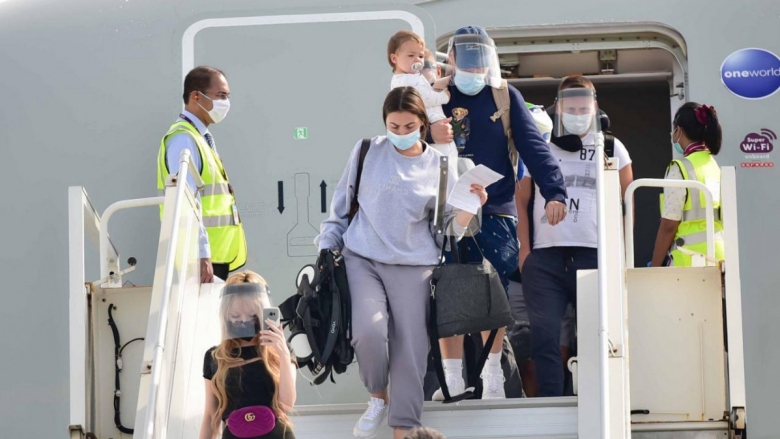
As tourism recovered, service exports and tourism-linked revenue collections also rose significantly. This led to improvements in the current account deficit and the country’s overall fiscal position. All sectors, except for construction which remains sluggish, showed a significant rebound. The poverty rate, which rose sharply to 11 percent in 2020 due to the pandemic, is also estimated to have fallen to 4 percent in 2021.
The MDU notes that these positive trends will likely continue this year and the next. This is thanks to increasing capacity in the tourism sector led by the completion of the Velana International Airport expansion and new resorts, a return of Chinese tourists after their border is reopened, and continued strong capital expenditures. As a result, tourism and the overall economy are projected to fully recover to pre-pandemic levels by 2023.
Despite the strong recovery, the Maldives faces significant risks, especially due to the country’s high debt burden and the global uncertainties linked to the ongoing war in Ukraine.
Rising from 4.9 and 0.8 percent in 2019, Russians and Ukrainians accounted for 16.8 and 2.7 percent of the 1.3 million arrivals in 2021, respectively. With the ongoing Ukraine war and the associated geopolitical implications, a prolonged absence of travellers from these two markets could negatively impact Maldives’ tourism sector. The MDU notes, however, that there are reasons to be optimistic, as increasing arrivals from other European markets such as the United Kingdom, Germany and Italy, and a surge in arrivals from new markets such as the Middle East could make up for the loss.
Although the impact of the war on tourist arrivals and economic growth seems manageable, it will have other consequences. The war has already led to a spike in commodity prices and, as a result, Maldives is likely to face a higher current account deficit, inflationary pressures, and an additional fiscal burden given the likely increase in fuel and electricity subsidies. These channels may aggravate existing external and fiscal vulnerabilities.
Since 2016, the government has appropriately increased infrastructure spending to facilitate faster growth. As a result, construction activity, productivity, and medium-term economic prospects have all seen a significant boost. Funding for these major projects had come through non-concessional foreign sources and sovereign guarantees, increasing fiscal and debt vulnerabilities. These risks are unlikely to lessen especially with an election year ahead.
“Despite the strong recovery in Maldives’ economy, long-standing structural weaknesses remain and need to be addressed. Measures to improve fiscal sustainability and reduce debt vulnerabilities should be a priority as the country builds back better from the unprecedented COVID-19 shocks,” Faris H. Hadad-Zervos , the World Bank Country Director for Maldives, Nepal and Sri Lanka, said.
The MDU recommends that the Maldives moderates capital spending and ensures slower accumulation of new debt in order to create more buffers to manage unforeseen risks and improve fiscal prospects. It notes that better sequencing and prioritisation of investment projects, with better growth-enhancing prospects, remain crucial for Maldives’ long-term growth and development.
This site uses cookies to optimize functionality and give you the best possible experience. If you continue to navigate this website beyond this page, cookies will be placed on your browser. To learn more about cookies, click here .

The Maldives is threatened by rising seas – but coastal development is causing even more pressing environmental issues
Associate Professor in Environment and Development, University of Reading
Disclosure statement
This research was funded by an ESRC-FCDO Development Frontiers Grant and an ESRC-FCDO Joint Fund Follow-on Grant.
University of Reading provides funding as a member of The Conversation UK.
View all partners
As UN climate conference COP26 approaches, vulnerable nations are rightly highlighting how they are threatened by climate change. One such nation is the Maldives, for whose inhabitants sea level rise could cause permanent devastation.
The Maldives has become emblematic of the challenges that sea level rise will bring to many societies around the world. The former president of the Maldives, Mohamed Nasheed, spoke on behalf of almost 50 climate-vulnerable countries when he stated that those living in threatened coastal areas and islands “are paying with our lives for the carbon someone else emitted”.
Yet while sea level rise is a serious threat, people in the Maldives report facing additional, more pressing environmental problems. These problems, while linked to climate change, are mainly related to coastal development and the growth in international tourism. Through speaking with islanders living on the front line of climate change, we uncovered the most urgent fears of local communities .
Beach erosion
The Maldives is made up of around 1,200 small islands. Of the country’s 450,000 people, around half live in the national capital of Malé. The other half live on small islands dispersed across the archipelago. There are also around 150 luxury resort islands mainly inhabited by tourists and resort staff.

Beach erosion is commonly reported as the main environmental threat that the country faces. Beach erosion categorised by the government as “ severe ”, where land is being rapidly lost to the sea, is present today on most inhabited islands.
It is widely understood that the main cause of rapid beach erosion is coastal development, especially the construction of new harbours. While harbours help to connect island communities and bring economic opportunities to residents, they can also dramatically change how sand moves along the shoreline.
These changes can cause whole beaches to disappear. This, in turn, leads to more frequent coastal flooding and a greater risk of people’s homes being washed into the sea. On many islands, communities often attempt to build sea defences, such as seawalls , in response. However, these are costly, with limited effectiveness.
- Plastic waste
An estimated 860 tonnes of solid waste is discarded daily in the Maldives, with around 21% due to tourism. Plastic makes up a significant proportion of this waste. Every day, plastic debris, including bags, bottles and food sachets, wash up in large quantities on beaches across the islands.

Large quantities of debris also wash up from further away, such as fishing nets used by Sri Lankan and Indian fishing fleets in the Indian Ocean. Nets are rarely used in the Maldives, where fishing with poles and lines is customary. However, large quantities of discarded nets still become entangled in rocks and plants along the shoreline.
These plastics look unattractive, can be swallowed by marine life, and release toxic chemicals when they break down. Many island communities regularly organise litter pickups, but are often unable to keep up with the frequency with which new waste arrives.

Many islands in the Maldives are densely populated , with hundreds of people living within just a few square kilometres. As a result, space for housing and social infrastructure such as schools and health clinics is in short supply.
In 2009, the government passed a new law allowing international tourists to stay in guesthouses on inhabited islands for the first time. What resulted was rapid and extensive construction of guesthouses, restaurants and cafes on many islands, boosting local job opportunities.

But this expansion is putting strain on the local environment, as construction uses up huge amounts of the local sand and groundwater. It’s also harming the health of coastlines, as beach space is reduced further and further due to erosion from the sea and encroachment by buildings on land.
Land reclamation, involving the pumping of huge quantities of sand from the seabed onto the shoreline, is a common way to create more space. But this risks throwing the delicate balance of the seabed’s ecosystem out of balance.

While local communities are highly resourceful and understand intimately how their physical environment functions, they have limited financial resources to take action. What’s more, if these problems remain unaddressed then they risk undermining the abilities of communities to cope with longer term pressures caused by sea level rise, such as stronger sea swells and more flooding.
Ultimately, if global attention is focused on the sea level , we run the risk of overlooking other crucial environmental problems intertwined with climate change. As well as undertaking the essential job of cutting greenhouse gas emissions, leaders at COP26 need to recognise the immediate priorities of local communities in small island nations like the Maldives.
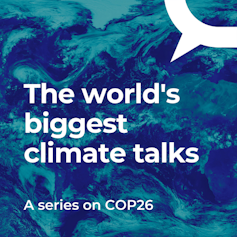
This story is part of The Conversation’s coverage on COP26, the Glasgow climate conference, by experts from around the world. Amid a rising tide of climate news and stories, The Conversation is here to clear the air and make sure you get information you can trust. More.
- Climate change
- Sea level rise
- Climate crisis

Program Manager, Teaching & Learning Initiatives

Lecturer/Senior Lecturer, Earth System Science (School of Science)

Sydney Horizon Educators (Identified)

Deputy Social Media Producer

Associate Professor, Occupational Therapy
- Work & Careers
- Life & Arts
Become an FT subscriber
Try unlimited access Only $1 for 4 weeks
Then $75 per month. Complete digital access to quality FT journalism on any device. Cancel anytime during your trial.
- Global news & analysis
- Expert opinion
- Special features
- FirstFT newsletter
- Videos & Podcasts
- Android & iOS app
- FT Edit app
- 10 gift articles per month
Explore more offers.
Standard digital.
- FT Digital Edition
Premium Digital
Print + premium digital, weekend print + standard digital, weekend print + premium digital.
Today's FT newspaper for easy reading on any device. This does not include ft.com or FT App access.
- 10 additional gift articles per month
- Global news & analysis
- Exclusive FT analysis
- Videos & Podcasts
- FT App on Android & iOS
- Everything in Standard Digital
- Premium newsletters
- Weekday Print Edition
- FT Weekend Print delivery
- Everything in Premium Digital
Essential digital access to quality FT journalism on any device. Pay a year upfront and save 20%.
- Everything in Print
Complete digital access to quality FT journalism with expert analysis from industry leaders. Pay a year upfront and save 20%.
Terms & Conditions apply
Explore our full range of subscriptions.
Why the ft.
See why over a million readers pay to read the Financial Times.
International Edition
share this!
October 28, 2021
The Maldives is threatened by rising seas, but coastal development is causing even more pressing environmental issues
by Alex Arnall, The Conversation
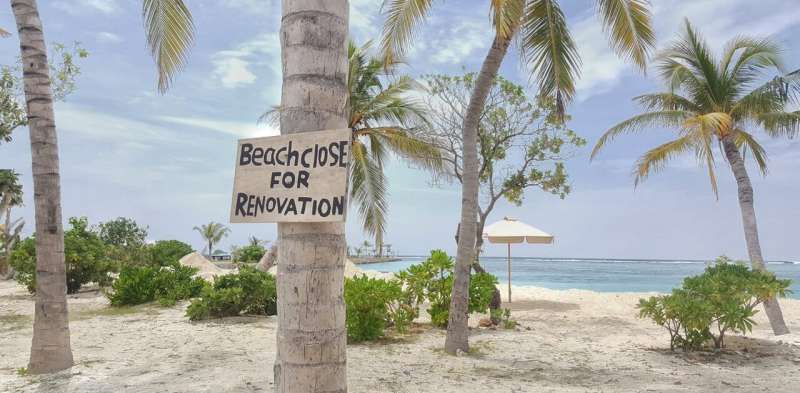
As UN climate conference COP26 approaches, vulnerable nations are rightly highlighting how they are threatened by climate change. One such nation is the Maldives, for whose inhabitants sea level rise could cause permanent devastation.
The Maldives has become emblematic of the challenges that sea level rise will bring to many societies around the world. The former president of the Maldives, Mohamed Nasheed, spoke on behalf of almost 50 climate-vulnerable countries when he stated that those living in threatened coastal areas and islands "are paying with our lives for the carbon someone else emitted".
Yet while sea level rise is a serious threat, people in the Maldives report facing additional, more pressing environmental problems . These problems, while linked to climate change , are mainly related to coastal development and the growth in international tourism. Through speaking with islanders living on the front line of climate change, we uncovered the most urgent fears of local communities .
Beach erosion
The Maldives is made up of around 1,200 small islands. Of the country's 450,000 people, around half live in the national capital of Malé. The other half live on small islands dispersed across the archipelago. There are also around 150 luxury resort islands mainly inhabited by tourists and resort staff.
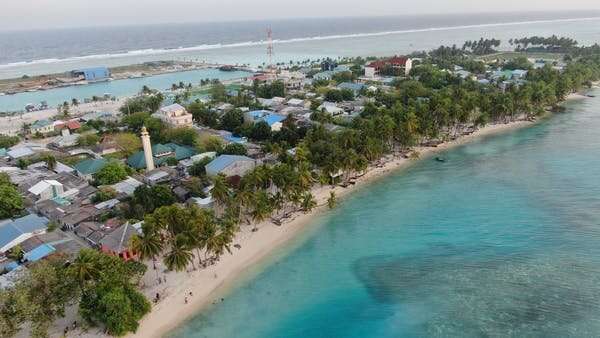
Beach erosion is commonly reported as the main environmental threat that the country faces. Beach erosion categorized by the government as " severe ", where land is being rapidly lost to the sea, is present today on most inhabited islands.
It is widely understood that the main cause of rapid beach erosion is coastal development, especially the construction of new harbors. While harbors help to connect island communities and bring economic opportunities to residents, they can also dramatically change how sand moves along the shoreline.
These changes can cause whole beaches to disappear. This, in turn, leads to more frequent coastal flooding and a greater risk of people's homes being washed into the sea. On many islands, communities often attempt to build sea defenses, such as seawalls , in response. However, these are costly, with limited effectiveness.
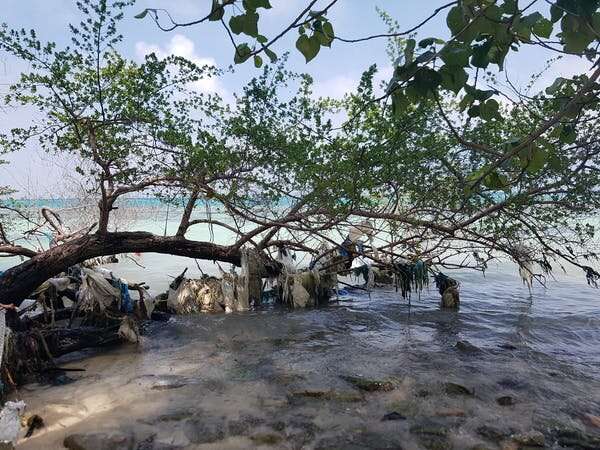
Plastic waste
An estimated 860 tons of solid waste is discarded daily in the Maldives, with around 21% due to tourism. Plastic makes up a significant proportion of this waste. Every day, plastic debris, including bags, bottles and food sachets, wash up in large quantities on beaches across the islands.
Large quantities of debris also wash up from further away, such as fishing nets used by Sri Lankan and Indian fishing fleets in the Indian Ocean. Nets are rarely used in the Maldives, where fishing with poles and lines is customary. However, large quantities of discarded nets still become entangled in rocks and plants along the shoreline.
These plastics look unattractive, can be swallowed by marine life, and release toxic chemicals when they break down. Many island communities regularly organize litter pickups, but are often unable to keep up with the frequency with which new waste arrives.
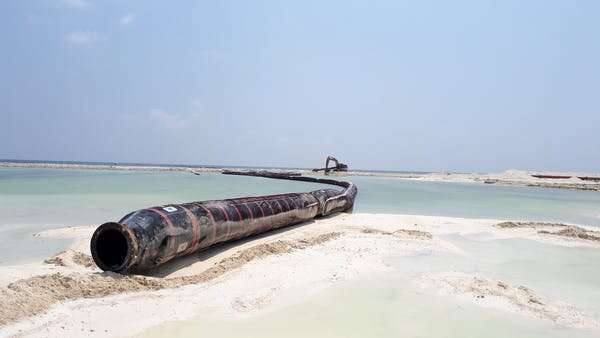
Many islands in the Maldives are densely populated , with hundreds of people living within just a few square kilometers. As a result, space for housing and social infrastructure such as schools and health clinics is in short supply.
In 2009, the government passed a new law allowing international tourists to stay in guesthouses on inhabited islands for the first time. What resulted was rapid and extensive construction of guesthouses, restaurants and cafes on many islands, boosting local job opportunities.
But this expansion is putting strain on the local environment, as construction uses up huge amounts of the local sand and groundwater. It's also harming the health of coastlines, as beach space is reduced further and further due to erosion from the sea and encroachment by buildings on land.
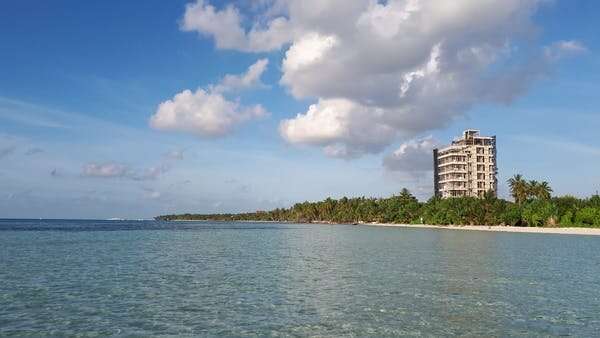
Land reclamation, involving the pumping of huge quantities of sand from the seabed onto the shoreline, is a common way to create more space. But this risks throwing the delicate balance of the seabed's ecosystem out of balance.
While local communities are highly resourceful and understand intimately how their physical environment functions, they have limited financial resources to take action. What's more, if these problems remain unaddressed then they risk undermining the abilities of communities to cope with longer term pressures caused by sea level rise, such as stronger sea swells and more flooding.
Ultimately, if global attention is focused on the sea level , we run the risk of overlooking other crucial environmental problems intertwined with climate change. As well as undertaking the essential job of cutting greenhouse gas emissions, leaders at COP26 need to recognize the immediate priorities of local communities in small island nations like the Maldives.
Provided by The Conversation
Explore further
Feedback to editors

Study suggests host response needs to be studied along with other bacteriophage research
15 minutes ago

New multi-task deep learning framework integrates large-scale single-cell proteomics and transcriptomics data
20 minutes ago

How to clean up New Delhi's smoggy air
28 minutes ago

Scientists simulate magnetization reversal of Nd-Fe-B magnets using large-scale finite element models
40 minutes ago

Gigantic Jurassic raptor footprints unearthed in China

Scientists discover safer alternative for an explosive reaction used for more than 100 years
41 minutes ago

New structures offer insight into how a bacterial motor powers bacterial chemotaxis, a key infectious process
51 minutes ago

Genomic analysis of a species of zooplankton questions assumptions about speciation and gene regulation

Genetic hope in fight against devastating wheat disease

Thiol-ene click reaction offers a novel approach to fabricate elastic ferroelectrics
Relevant physicsforums posts, unlocking the secrets of prof. verschure's rosetta stones.
15 hours ago
Large eruption at Ruang volcano, Indonesia
Apr 23, 2024
Tidal friction and global warming
Apr 20, 2024
Iceland warming up again - quakes swarming
Apr 18, 2024
M 4.8 - Whitehouse Station, New Jersey, US
Apr 6, 2024
Major Earthquakes - 7.4 (7.2) Mag and 6.4 Mag near Hualien, Taiwan
Apr 5, 2024
More from Earth Sciences
Related Stories

Maldives records highest level of micro plastic pollution on the planet
Aug 5, 2020

Image: Jewels of the Maldives
Feb 15, 2019

Maldives tightens tourist virus rules after spike in cases
Sep 2, 2020

Maldives: Climate change could actually help coral islands rise again – but they're still at risk
Nov 14, 2018

Lake formation and expansion due to sea-level rise causes freshwater resource depletion on small islands
Oct 12, 2021

Copernicus captures image of the Republic of Maldives
Oct 30, 2020
Recommended for you

Scientists say voluntary corporate emissions targets not enough to create real climate action
20 hours ago

Managing meandering waterways in a changing world
19 hours ago

Cocaine is an emerging contaminant of concern in the Bay of Santos (Brazil), says researcher
22 hours ago


Warming Arctic reduces dust levels in parts of the planet, study finds

Study shows the longer spilled oil lingers in freshwater, the more persistent compounds it produces
Let us know if there is a problem with our content.
Use this form if you have come across a typo, inaccuracy or would like to send an edit request for the content on this page. For general inquiries, please use our contact form . For general feedback, use the public comments section below (please adhere to guidelines ).
Please select the most appropriate category to facilitate processing of your request
Thank you for taking time to provide your feedback to the editors.
Your feedback is important to us. However, we do not guarantee individual replies due to the high volume of messages.
E-mail the story
Your email address is used only to let the recipient know who sent the email. Neither your address nor the recipient's address will be used for any other purpose. The information you enter will appear in your e-mail message and is not retained by Phys.org in any form.
Newsletter sign up
Get weekly and/or daily updates delivered to your inbox. You can unsubscribe at any time and we'll never share your details to third parties.
More information Privacy policy
Donate and enjoy an ad-free experience
We keep our content available to everyone. Consider supporting Science X's mission by getting a premium account.
E-mail newsletter
UN Tourism | Bringing the world closer
Share this content.
- Share this article on facebook
- Share this article on twitter
- Share this article on linkedin
Maldives’ tourism looking up after reopening
- Asia and the Pacific
Despite challenges faced during the year, the Maldives welcomed a total of 555,494 international tourists in 2020. In January 2021, arrival numbers stood at 92,103 and it increased to 99,397 by 3rd February 2021 with a daily average of 2,923 tourists. Though this was a decline of 47.5% compared with that of 2020, tourists are seen spending their holidays for longer duration, extending the average duration of stay in the Maldives from 7.2 days in 2020 to 9.2 days in 2021.
The Maldives observed significant changes to its top markets since re-opening of borders on 15 July 2020. As of 3rd February 2021, Russia stood at the top as the number one market with 23% shares and 22,365 tourists. India followed closely behind with 21% shares and 20,933 tourists. Ukraine, which made it to the top market list of Maldives after the re-opening of borders, stood third in the list contributing 7.8% shares with 7,709 tourists. Other top source markets include Kazakhstan (4.9%), France (4.5%), Romania (3.8%), Germany (3.7%), United Kingdom (2.6%), Czech Republic (2.2%) and U.S.A (2.1%).
The Maldives is seeing optimistic results with recovery trends from Central/Eastern Europe and South Asian region as well as some markets from the Middle East and Americas. Central/Eastern Europe and South Asia posted a double-digit growth of 63.9% and 24.6% respectively in 2021 as of 3rd February. Individual markets such as Ukraine, Kazakhstan and Romania posted growth rates over 100%.
Since the re-opening of Maldives borders, 27 scheduled airlines are operating to the Maldives, from various countries across the globe, most of them being long haul. The highest number of movements and passengers came from Emirates, Qatar Airways, Indigo, Go Air and Aeroflot. With the rapid growth in new markets from Central and Eastern Europe, 6 flights from the region are now operating to the Maldives.
Looking at COVID-19 situation in the Maldives, as of 3rd February over 3000 samples are being tested daily, which includes departure samples. The tourist’s positivity rate, as a percentage of total arrivals remain significantly low at 0.08% in January 2021. As of 3rd February 2021, there are 3 COVID-19 hospital facilities in greater Male’ area with 266 beds and additional 6 COVID-19 hospital facilities across the country with a total of 188 beds. In isolation facilities, tourists stay in private areas with special arrangements and are closely monitored by healthcare professionals.
The Maldives tourism recovery drive has been anchored on facilitating maximum safety and security possible to tourists, employees and the public, with minimal inconvenience. With over 87% of the total 51,000 beds now in operation in resorts, hotels and guesthouses, and liveaboard safari boats, Maldives expects to welcome 1.5 million tourists and 10 million bed nights in 2021.
Please download
- Maldives Tourism Updates 2023 Issue - 29 as of 20 July 2023 here .
- Maldives Tourism Updates 2023 Issue - 09 as of 02 March 2023 here .
- Maldives Tourism Bulletin, June 2023, here
Facing dire sea level rise threat, Maldives turns to climate change solutions to survive
The islands could be 80% uninhabitable by 2050 at current global warming rates.
The Maldives are well known as a bucket list getaway. Hearing the country's name conjures up images of luxury huts overlooking an aqua blue ocean. But climate change may cross the country off the map completely.
The archipelago, which is made up of over 1,100 coral islands in the middle of the Indian Ocean, is the lowest lying nation in the world. Therefore, sea level rise caused by global climate change is an existential threat to the island nation. At the current rate of global warming, almost 80% of the Maldives could become uninhabitable by 2050, according to multiple reports from NASA and the U.S. Geological Survey.
"Our islands are slowly being inundated by the sea, one by one," Ibrahim Mohamed Solih, the president of the Maldives, told the U.N. Climate Change Conference, or COP26, earlier this week. "If we do not reverse this trend, the Maldives will cease to exist by the end of this century."
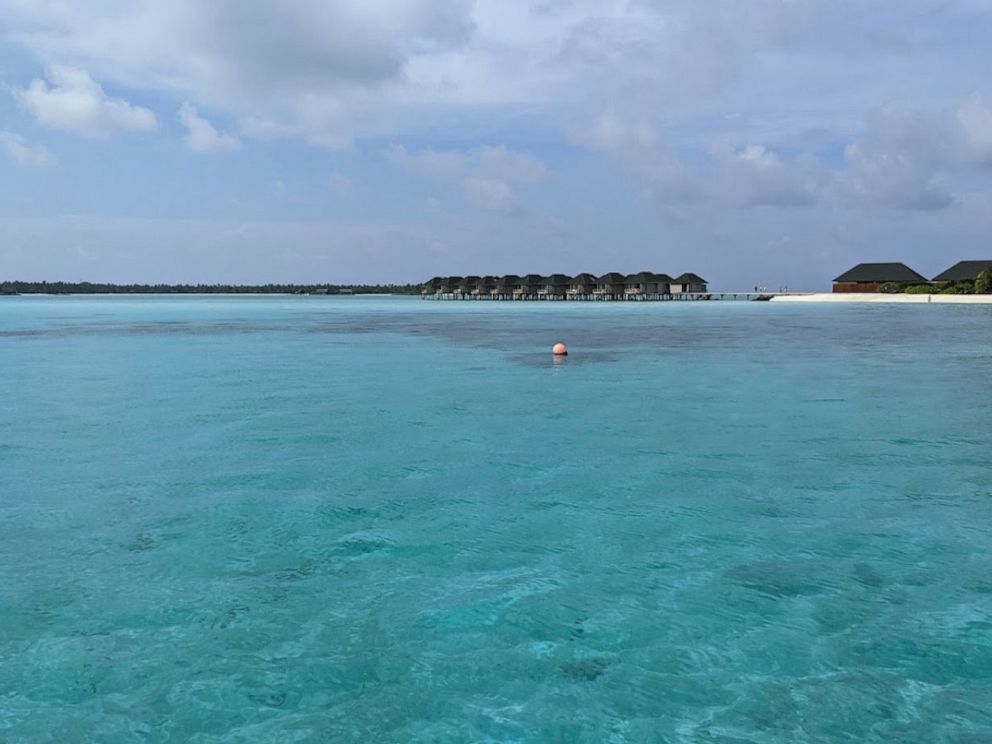
The islands that are home to local Maldivians, not the resort islands, stand to lose the most. Mohammed Nasheed, the former president of the Maldives and a leading voice for climate change equity, told ABC News that more than 90% of islands in the Maldives have severe erosion, and 97% of the country no longer has fresh groundwater.
Ibrahim Mubbasir and his family live on the island of Dhiffushi. It is suffering from severe erosion, and flooding has increased from two or three times a year to twice a month. Four years ago, the family's well became unusable because of salt water contamination, leaving them to rely on collecting rainwater. Mubbasir said they only have enough fresh water to last for three more months.
"Things that we thought would happen towards the end of the century, we are experiencing now," Aminath Shauna, the Maldives' minister of environment, climate change and technology, told ABC News' Ginger Zee.
Shauna said that more than 50% of the national budget is spent on adapting to climate change. When asked what the Maldives will look like in 2050, Shauna responded, "Are you willing to take the Maldives as climate refugees? I think that's the conversation that needs to happen."
And it's not just the Maldives. Island countries around the world have been asking developed nations for funds since 2009. Countries with the highest greenhouse gas emissions -- China, the United States and India -- are mostly responsible for the rapid sea level rise.
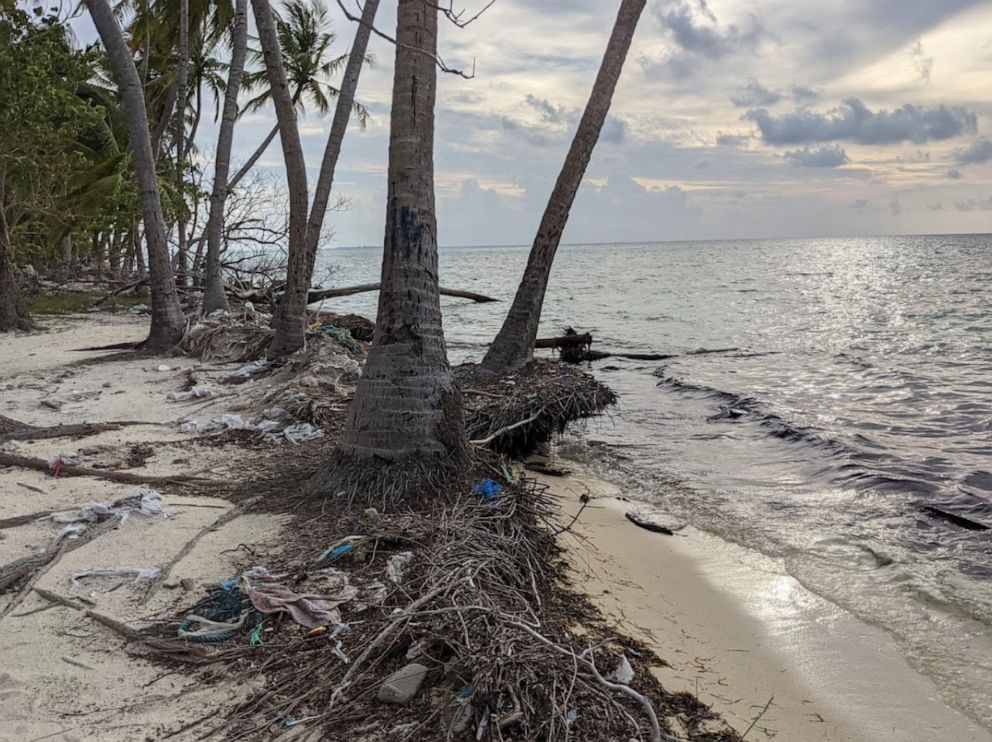
Maldives' coral reefs
At the center of the Maldives' culture are their coral reefs.
In 2016, the Maldives lost their front line of defense when a bleaching event affected about 60% of the coral reefs, according to Aya Naseem, a marine biologist and co-founder of the Maldives Coral Institute.
Without coral reefs, the islands are wide open to the rising waters. Naseem said they have one realistic choice: They need to build back and protect the reefs, "because IPCC (Intergovernmental Panel on Climate Change) is predicting that by 2050 if the temperature rises 1.5 degrees Celsius we can lose 70 to 90% of corals in the whole world."
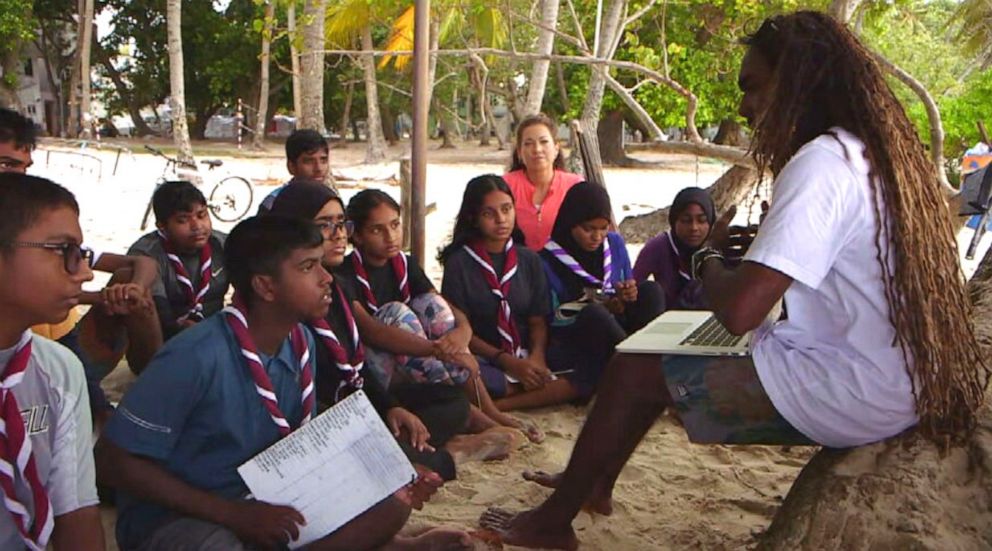
Research has previously shown that a healthy coral reef can absorb 97% of wave energy, dramatically reducing erosion, and it's affordable, Naseem said.
"It's much cheaper than building a seawall. I think it costs something like $3,000 to grow a meter of sea wall where for the coral a meter of it is about $300, including monitoring and everything," she said.
Bebe Ahmed, founder of "Save the Beach," travels island to island in the Maldives with the mission of teaching kids about restoring and protecting coral. He told ABC News that his dream is to inspire young Maldivians to want to start their own projects to restore coral reefs.
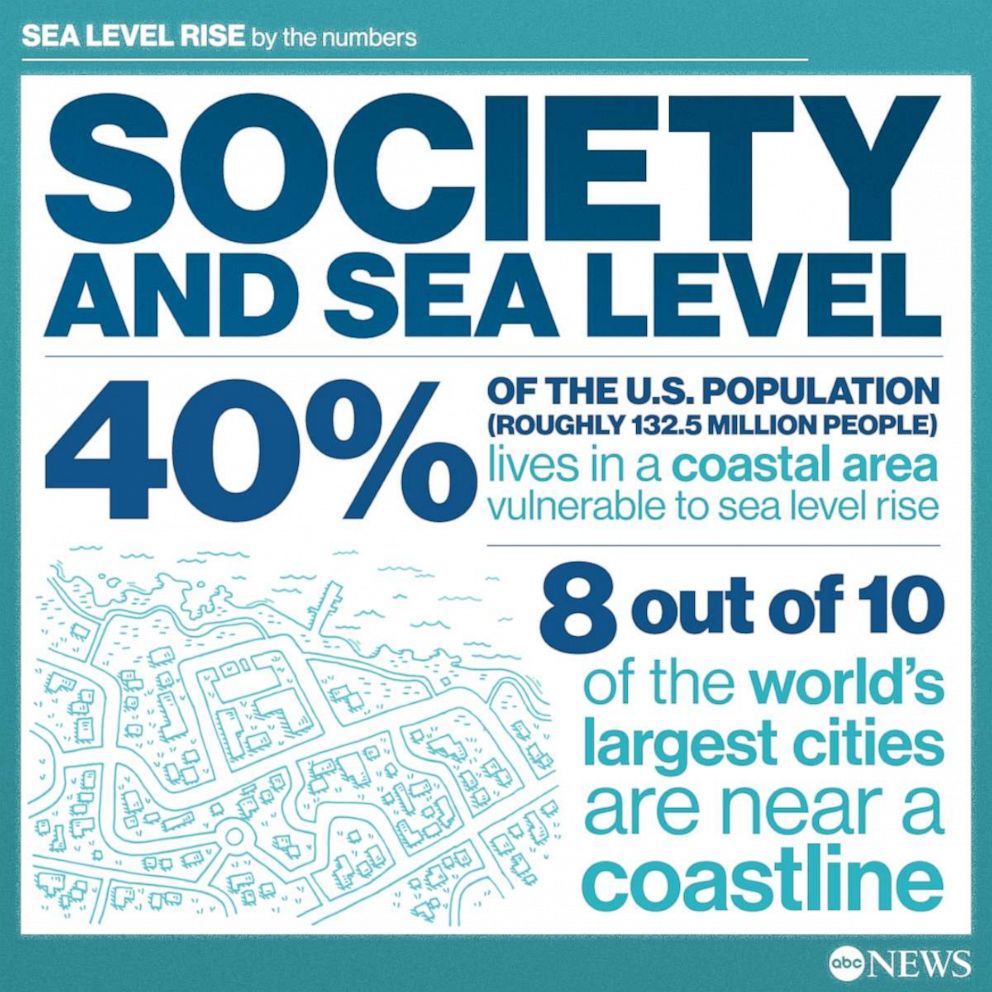
MORE: COP26 updates: 'America showed up,' Biden says of time at summit
What's next in the fight?
Technology, like 3D-printed coral structures or a floating city, may have to be part of the solution.
The Maldives is home to the Modular Artificial Reef Structure, or MARS, a coral-forming project on the resort island of Summer Island. to the coral forming project, MARS. The project has 3D-printed bases that are placed in the water with transplant corals attached to them. The hope is that the system is designed with the specific needs of the coral farm in mind, providing a permanent structure for coral to grow.
In the late '90s, the Maldives began construction on the island of Hulhumale through the process of land reclamation. Hulhumale is 6.5 feet above sea level, more than double the height of Male, the current capital of the Maldives. It is possible this island may be a future site for relocation of Maldivians suffering from sea level rise. Maldivians call their manmade island the City of Hope.
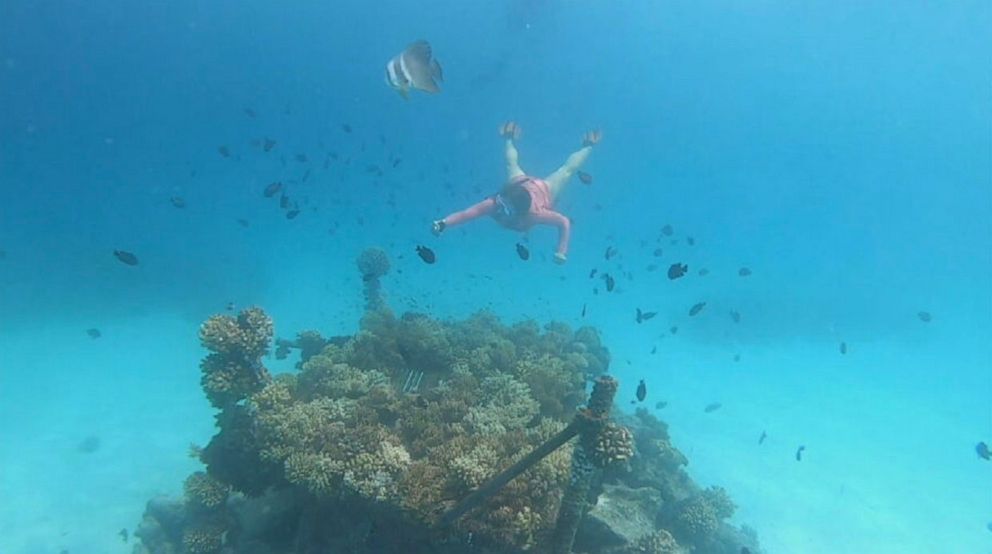
The future of the Maldives could also come in the form of a floating city. In 2022, just a few miles from the dense, capital city of Male, construction and assembly will begin on the world's first true floating city. The unique solution will not have to worry about sea level rise, because it will always be on top of the sea.
The project is being developed and led by Dutch Docklands in the Netherlands. Lead architect Koen Olthuis gave ABC News an inside look at how the floating city is designed and what it should eventually look like.
MORE: India's addicted to coal. But for how much longer?: Reporter's Notebook
The floating city has a unique pattern, modeled after the brain, both human and coral.
The entire city will shift up and down on a pile drilled into the sea floor. It will also take advantage of its environment to better provide for those living on the floating city.
"By being on the water we want to take advantage of the water -- and using the coolness of the water -- so these are water-cooled cities, for which you take cool water outside the atoll and pump water through the route and activate the air conditioning systems," Olthius said.
Since the floating city is sustainable and leaves no footprint, Olthuis called the floating cities "scarless" and said they are "renting space from nature."
Related Topics
- Climate Change

Technology and Operations Management
Mba student perspectives.
- Assignments
- Assignment: Climate Change Challenge
That Sinking Feeling – How the Ministry of Tourism in The Maldives Addresses Climate Change

With rising temperatures and sea levels, The Maldives finds itself sinking – both economically and literally.
Rising sea levels caused by climate change pose varying risks to multiple companies, non-profits and organizations. But how should an organization address the challenges of climate change when they not only threaten business operations, but the very livelihood and even existence of an entire nation?
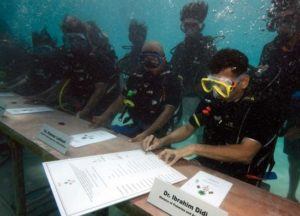
The Maldives is currently facing such a situation. The archipelago nation consisting of nearly 1200 islands is surrounded by rising seas and temperatures that threaten the source of nearly 70% of the country’s GDP – Tourism [1]. As the waters continue to creep towards shore, risking to swallow the nation completely, the nation’s Ministry of Tourism looks to three primary threats to its economic livelihood:
1) Everything Is Not Beachy

With vast coastlines surrounded by the blue of the Indian Ocean, The Maldives is renowned for its beautiful beaches. Nearly 75% of tourism is driven by Beach Holidays [2], and almost all tourist accommodations are within 100 m of the coastline [7]. This draw for tourists is at risk though from rising sea levels and beach erosion. Over 97% of the inhabited islands reported beach erosion [2], and nearly half of the tourist resorts also reported erosion damage caused by increasingly higher water levels [5].
Pathways to Just Digital Future
2) Nothing is Better, Down Where It’s Deader, Under the Sea

Below the water’s surface, The Maldives also attracts tourists with its rich biodiversity. With the seventh largest coral reef system globally [5], tourists flock to The Maldives for excellent snorkeling and diving. However, climate change is endangering this fragile natural resource. The living coral reefs are highly susceptible to the rising water temperatures, and the impact of climate change has been a phenomena called Coral Bleaching that destroys the once rich underwater environment [3]. Since coral reefs are the foundation of the aquatic ecosystem, all of The Maldives’ biodiversity is threatened as the reefs slowly fall apart.

3) Now Servicing Non-Stop Flights to Atlantis
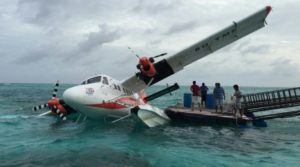
In addition to the natural resources at risk from climate change, the man-made infrastructure supporting the tourism industry also faces challenges from rising sea levels. With approximately 90% of resort infrastructure within 100 m of a coastline only 1.5 m above sea level [7][5], any increases in sea level threaten to significantly impair the nation overall. Furthermore, the tourism industry’s most utilized point of entry, Male’ International Airport, is particularly at risk with over 30% of its infrastructure within 50 m of the coast and only 1.1 m above sea level [2][7]. As the water continues to rise, the primary source of nearly all tourism could be completely cut off with any damages to Male’ International Airport’s infrastructure.
The Tourism Adaptation Project
To ensure tourism and economic operations can continue in spite of climate changes, The Maldives Ministry of Tourism launched the Tourism Adaptation Project. This joint venture between public and private sectors seeks to mitigate the impacts of rising sea levels and temperatures through a myriad of operational enhancements and alterations.
Certain mitigation techniques are very short-term focused. One solution to the concerns around coastline erosion are to utilize beach nourishment techniques [11]. Popular among beachfront resorts, sediment and sand would be moved from different areas of the archipelago and pumped into eroded beaches, repairing eroded areas for a quick, albeit temporary fix. [4]
A more lasting solution involves the usage of organic solutions. On the erosion side, one such strategy is to plant vegetation such as mangroves around the coastline [7]. Studies have shown that the plants not only weaken waves caused by rising sea levels and weather, thereby decreasing erosion, but are also useful in improving biodiversity as well [8]. Utilizing organic solutions is also effective in addressing the risks to coral reefs. By planting either actual or artificial coral reefs, the aquatic ecosystem can be stabilized thus driving sustainability to biodiversity, and subsequently the snorkeling and diving industries. [6][10]
Finally, additional infrastructure can leave long-lasting safeguards to climate change. A common measure is to build seawalls to prevent damage to coastline and existing infrastructure [6]. Furthermore, Male’ International Airport is undergoing additional runway development and coastal protections to help minimize the risks generated from rising sea levels. [9]
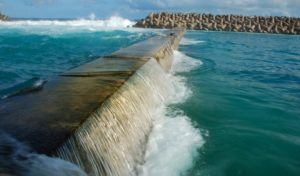
Is It Enough?
While the Ministry’s Adaptation Project provides many defenses from the impacts of climate change, they are mostly short-term responses rather than actual lasting solutions. Safeguards can be introduced and emissions cut within the country, but the global problem of climate change will still threaten the nation. In order to ensure sustainability of tourism and The Maldives itself, the country has pushed for multilateral policy changes urging other nations to adopt climate change mitigation agreements such as the Paris Climate Agreement [12]. Only by looking for a global solution to this shared problem can the natural beauty of The Maldives be preserved for generations of tourists to come.
[796 words]
References:
[1] Bureau of Economic and Business Affairs, “2014 Investment Climate Statement – Maldives,” http://www.state.gov/e/eb/rls/othr/ics/2014/227151.htm , accessed November 2016.
[2] Ministry of Housing, Transport and Environment, “National Adaptation to Climate Change,” http://www.ifrc.org/docs/IDRL/National%20Adaptation%20Programme%20(Climate%20change))/MALDIVES%20Adaptation%20to%20Climate%20Change.pdf , accessed November 2016.
[3] Hoegh-Guldberg, Ove. “Climate change, coral bleaching and the future of the world’s coral reefs.” Marine and freshwater research 50, no. 8 (1999): 839-866. Accessed November 2016.
[4] Shakeela, Aishath, and Susanne Becken. “Understanding tourism leaders’ perceptions of risks from climate change: an assessment of policy-making processes in the Maldives using the social amplification of risk framework (SARF).” Journal of Sustainable Tourism 23, no. 1 (2015): 65-84. Accessed November 2016.
[5] Ministry of Environment, Energy and Water, “National Adaption Program of Action,” http://unfccc.int/resource/docs/napa/mdv01.pdf , accessed November 2016.
[6] Heather Hosterman, Joel Smith, “Economic Cost and Benefits of Climate Change Impacts and Adaptation to the Maldives Tourism Industry,” 2015, Ministry of Tourism, http://www.tourism.gov.mv/downloads/publicaltions/Economic.pdf , accessed November 2016.
[7] Sovacool, Benjamin K. “Perceptions of climate change risks and resilient island planning in the Maldives.” Mitigation and Adaptation Strategies for Global Change 17, no. 7 (2012): 731-752. Accessed November 2016.
[8] Duarte, Carlos M., Iñigo J. Losada, Iris E. Hendriks, Inés Mazarrasa, and Núria Marbà. “The role of coastal plant communities for climate change mitigation and adaptation.” Nature Climate Change 3, no. 11 (2013): 961-968. Accessed November 2016.
[9] Ministry of Environment and Energy, “Maldives’ Intended Nationally Determined Contribution,” http://www4.unfccc.int/ndcregistry/PublishedDocuments/Maldives%20First/Maldives%20INDC.pdf , accessed November 2016.
[10] Clark, S., and A. J. Edwards. “An evaluation of artificial reef structures as tools for marine habitat rehabilitation in the Maldives.” Aquatic Conservation: Marine and Freshwater Ecosystems 9, no. 1 (1999): 5-21. Accessed November 2016.
[11] Sovacool, Benjamin K. “Hard and soft paths for climate change adaptation.” Climate Policy 11, no. 4 (2011): 1177-1183. Accessed November 2016.
[12] Chris Mooney, Joby Warrick, “How tiny islands drove huge ambition at the Paris climate talks,” The Washington Post, December 12, 2015, https://www.washingtonpost.com/news/energy-environment/wp/2015/12/11/how-tiny-islands-drove-huge-ambition-at-the-paris-climate-talks/ , accessed November 2016.
Image References:
https://www.theguardian.com/environment/climate-consensus-97-per-cent/2016/jun/10/climate-scientists-have-warned-us-of-coral-bleaching-for-years-its-here
https://www.sciencenewsforstudents.org/article/current-coral-bleaching-event-longest-known
http://www.arkipal.org/tag/energy/
https://maldivesfinest.com/seaplane-accident
https://www.flickr.com/photos/shoken/3051775619
http://www.dailymail.co.uk/news/article-1221021/Maldives-underwater-cabinet-meeting-held-highlight-impact-climate-change.html
http://expatoftheworld.com/live-country-thats-sinking-island-president-tackling-climate-change-maldives/
Student comments on That Sinking Feeling – How the Ministry of Tourism in The Maldives Addresses Climate Change
This post highlights the challenges facing what will likely be one of the first nation-state victims of climate change–the Maldives. You point out several interesting (albeit temporary) mitigation efforts that the Maldives is currently pursuing. I’m wondering if they have looked at what others affected by rising tides, like the Netherlands, are doing? It seems the Maldives faces a stark choice at this point (barring some kind of massive shift in the trend towards warmer temperatures and higher tides): engineer their way to safety or leave the Maldives, or much of the Maldives behind. Is the Maldives considering installing lock systems, water diverting walls or other similar Dutch-inspired major engineering projects? If not, does the Maldives have a plan to relocate its population–either to higher ground or to another island? Both options pose significant operational challenges and fundamentally reshape what the Maldives is and will be in the future. What are businesses in the Maldives doing? Are they leading the way towards a solution or are they preparing to jump to safety?
Interesting you should pose that question TK, relocating the entire populace is exactly what their former president advocated at one point: http://www.nytimes.com/2009/05/10/magazine/10MALDIVES-t.html
I agree that more needs to be done because all the current solutions are strictly temporary but cannot see how such a small nation can structurally tackle this climate issue without cooperation of the large countries. Sea levels will continue to rise and overcome walls and re-erode beaches. Moreover, as temperature goes up, the negative effects happen faster so the returns on the temporary solutions might diminish over time.
Very interesting post! One of the images in your post rings a bell. I remember reading about how the government of the Maldives decided to hold a cabinet meeting underwater to raise awareness and bring much needed attention to the gravity of the problem! I agree with you that the measures which have been taken are only short-term. Building seawalls can probably be scaled to protect the nation’s inhabitants when sea levels rise to dangerous levels. However, this would destroy the natural beauty of the islands and could even be detrimental to the biodiversity.
I would be interested to hear your thoughts on long term measures you think should be taken. Considering the Maldives is a relatively small nation, it probably doesn’t have the ‘political clout’ to bring mass attention to the problem. Perhaps, the Maldives government can work with governments of neighboring countries in South Asia to support its cause at global climate change forums?
I’ve never been to the Maldives but it’s on my bucket list! I hope it’s not too late to experience the picturesque offerings of this archipelago.
Very interesting, Andrew. I think this article resonated a lot with me because we have the same issue with the Great Barrier Reef in Australia! In fact, Australia has exactly that – a long term plan that has a roadmap until 2050! Check it out here – http://www.environment.gov.au/marine/gbr/long-term-sustainability-plan
I agree with both you and the other commenters that there are long term measures that need to be taken, but given how reliant they are on tourism, it’s probably easier said than done. A couple of things that I thought that may help in curbing the demand of tourism is 1) restricting demand through pricing (although the Maldives is already an expensive location) and 2) replacing some of the access with virtual reality!
This truly exemplifies the negative externality problem that climate change brings, and the exacerbation of the problem when the third party sufferers of climate change are smaller countries with less political leverage and less capital. The Maldives face consequences for which there are no ideal solutions – temporary solutions are common because local businesses are only able to/willing to sink that much capital into retaining beaches for their own livelihood. When it comes to the large scale solutions that are necessary, the capital investment needed from the government will significantly increase national debt. Building a Dyke system (such as in the Netherlands) is a huge project to embark upon from scratch, and also requires huge infrastructural shifts. Hotels and other beach-side facilities will have to move in-land, and beaches will fall on the outside of the protected zone. Alternatives may come in drastic changes in urban planning – zoning laws to make all lower floors of buildings dispensable, shifting residential and commercial use into upper floors, and transitioning the city into a Venice-like destination. Should natural mangroves suffice to weather the worst of the storm, they may be the most cost effective and aesthetically appealing option. I really hope that we will see significant investment in the Maldives, hopefully with external investment and support, to develop a strong response for long-lasting resilience against the rising sea levels.
Tourism and environment is a topic that is often coupled in many areas of the region including Maldives. It is especially sensitive issue when the economy of region is highly dependent on the tourism industry. In this situation, it is extremely difficult to devise and implement solutions to mitigate the issue as it has direct impact on the welfare of the people. Although the short term measures do supplement the conservation efforts, there needs to be a policy in place where there are other sources of economic growth other than tourism to fundamentally resolve the issue.
Wow, this seems like a really tough problem. Unfortunately, the temporary solutions seem to be just that – temporary. If rises in sea level continue as projected, this will put the Maldives in an extremely challenging their position. I think it would be wise for the Maldives, hopefully with the help of some of its friends, to start taking a look at a really conservative strategy for compensating with worst-case rises in sea level so that they’re at least prepared and have an actionable, well thought out plan they can execute if necessary to minimize the adverse effects that would hit their tourism-based economy.
The ocean engineering part of this problem is very interesting. Beyond seawalls, I would like to learn more about the government’s long-term R&D projects. It would also be helpful to see the data on projected sea level changes to look at this problem against time. While tourism and the economic survival of the population is important in the present, the larger concern is that the Maldives is likely to disappear during this century.
As someone who has always wanted to visit Maldives, I found your post fascinating. However, I must admit – my view of Maldives was limited to beautiful pictures I had seen online and similar accounts from friends and family who had visited the islands. Naturally, I found some of the points that you brought up gripping. What are your thoughts on municipal wastes that are smothering corals in neighboring reefs? Did you consider the effects of inadequate municipal incineration that causes severe air pollution during the monsoon season? I’m wary that attempts to solve one environmental problem have merely resulted in the proliferation of others. Clearly, the Maldives faces a variety of economic and development problems that are compounded by a restricted natural resource base and rapid population growth.
Leave a comment Cancel reply
You must be logged in to post a comment.
Coral reefs are vital to the Maldives. This is how travelers can help restore them.

The coral fragment from the seafloor off the coast of the resort Siyam World Maldives in the Noonu Atoll had a stark contrast. One inch of the coral’s light brown tips was bumpy with living polyps, while the rest was dull white, resembling a dead tree branch.
This coral species, known as acropora hemprichii, grows in the shallow reefs of the Maldives in tapered branches which eventually look like a bush or dome as they grow.
That piece of coral I spotted broke off from its home likely due to a powerful wave or a careless snorkeler. Once it fell into the sand, it began to die off. To the untrained eye, it seemed like there was no hope for that little coral fragment.
However, that fragment was far from dead, and the solution to reviving it was simple.
Coral planting is a simple act of fastening a coral fragment to a metal frame and placing it in a safe, shallow area of the ocean. In mere months, the coral has the potential to flourish once again. As the corals regenerate, the reef becomes more habitable for fish, that swim through and make the frames part of their home. Over 25% of the world’s fish inhabit and get their food from coral reefs.
Learn more: Best travel insurance
As climate change and human activity continue to threaten coral reefs, tropical destinations such as the Maldives are turning to coral restoration initiatives, such as coral planting, to save the ocean, which they heavily rely on for tourism and the local way of life.
Resort guests are encouraged to get involved and protect the very ocean that drew them to the Maldives in the first place – and the call is being answered. According to Booking.com’s Sustainable Travel Report 2023, two-thirds of its 33,000 survey respondents said they “want to leave the places they visit better than when they arrived.”
“Ninety-nine percent of people come to the Maldives for the ocean because they want to snorkel,” said Mariyam “Thuhu” Thuhufa, a marine biologist at Siyam World Maldives, which offers marine conservation activities for guests including coral planting and lagoon cleanups. “A lot of them do get very curious, a lot of them are keen to understand what they can see and how they can help.”
No one went to the Maldive 50 years ago: Now it's one of the hottest destinations.
How important are coral reefs to the Maldives?
The Maldives is an archipelago of over 1,000 islands sitting mere feet above sea level, which means the country is 99% ocean. And that’s where most of the natural diversity exists, from manta rays in the north to hammerhead sharks in the south.
“Without the ocean, the Maldives just can’t exist,” said Thuhufa.
All Maldivians depend on the ocean in some way, 71% rely on it for their primary source of income . Maldivians get food from line fishing at coral reefs, such as snapper or emperor fish. Fishing for big game fish like tuna is also the second largest industry , following tourism.
Without healthy coral reefs, the islands wouldn’t even exist. “If you go to a local island, you’ll see a lot of the houses are built very close to the ocean, right next to the beach,” said Thuhufa. During monsoon season, from May to November, big swells wash away the beaches, but a healthy reef can break the wave energy before it reaches the island, she said.
The fate of coral reefs are in resorts’ hands
To Thuhufa, coral bleaching is one of the most pressing issues for the islands and “something the whole world is experiencing.” The last mass bleaching event , which occurred between 2014 and 2017, saw 15% of the world’s reefs die off. The National Oceanic and Atmospheric Administration predicts a fourth, even worse mass bleaching this year.
"It's looking like the entirety of the Southern Hemisphere is probably going to bleach this year," said ecologist Derek Manzello, the coordinator of NOAA's Coral Reef Watch which serves as the global monitoring authority on coral bleaching risk.
“We are literally sitting on the cusp of the worst bleaching event in the history of the planet,” he said. Up to 90% of the world’s corals could be lost.
Story continues below.
Thuhufa recalled an uninhabited island she visited for volunteer research work in high school. “The reef was so beautiful with so many vibrant colors,” she said. After the 2016 bleaching, she returned to the island to see how it was affected. “It was the most devastating thing I’ve seen,” she said. “Everything was bleached, everything was covered in algae.”
With tourism as the country’s biggest industry, resorts play a vital role in the protection of coral reefs.
Although construction and increased human activity can damage the fragile ecosystems of reefs, many resorts in the Maldives are working to protect their house reefs by hiring in-house marine biologists and creating nurseries for coral planting. New resorts in the Maldives need to undergo an impact assessment before they can break ground (or sand in their case).
A 2018 study analyzing the direct impact of seven luxury Maldivian resorts on coral reef health found that the amount of live coral and the size of colonies increased over time if the resort had conservation initiatives in place.
“Your reef is protected in the sense that there’s no fishing, and guests are told not to touch corals,” Thuhufa said. “A lot more is put into the reefs to keep them healthy.”
However, the study also revealed that resorts with poor management practices and more sedimentation and runoff can harm the reefs.
What is it like to plant coral?
I tried coral planting for the first time during my stay at Siyam World Maldives, and it was surprisingly easy and engaging.
Guests can book the experience via the resort app, which they download during check-in, or their resort ambassador can arrange it.
Coral planting is an emerging type of coral restoration , and since it’s only been done on a small scale, it doesn’t tackle the root of the problem of coral bleaching or warming temperatures. It can, however, help make a specific reef a bit more habitable and spread awareness of the condition of coral reefs.
The marine biology team met me on the beach with a hexagon-shaped metal frame and two containers filled with coral fragments they found. One by one, we attached the coral pieces to the frame using zip ties, ensuring they were flush with the metal. This way, the coral will merge and regrow over the frame.
We splashed water on the corals every half hour to ensure they didn’t dry out. When the frame was finished, we placed it in a shallow snorkeling area to join over 100 other coral frames. The marine biology team checked on the frames and removed any algae so the coral could breathe. The frames come in shapes like hearts or rays but remain open for fish to swim through.
Although coral is sensitive, it’s also a resilient animal – yes, corals are technically considered tiny animals since, unlike plants, they don’t make their own food. Sometimes as small as a pencil tip, polyps make up the coral structure we see and attach to rocks, the seabed or in this case, a metal frame.
Depending on the species of coral – and there are hundreds – the coral can take around five months to attach to the frame and then a few more months to regrow, according to Thuhufa.
As I dove underwater to explore the coral nursery, I noticed batfish, triggerfish and other colorful reef fish seamlessly swimming between anemones and among the coral frames.
Kathleen Wong is a travel reporter for USA TODAY based in Hawaii. You can reach her at [email protected] .
Contributing: Reuters

- Press Vacancies Contact Us
Climate-Induced Loss and Damage and Cultural Loss in Maldives: A Case Study
Maldives’s exclusive economic zone (EEZ) consists of only 1% land across 1,192 small islands and 99% sea, comprising the world’s seventh largest reef system. The seas teeming with marine flora and fauna, white sandy beaches, and year-round warm weather make the country a leading tourist destination. However, these very elements are also compounding factors in Maldives’ extreme vulnerability to climate change and its devastating impacts. The Intergovernmental Panel on Climate Change (IPCC) AR6 Synthesis Report confirms that widespread climate-induced loss and damage is a reality today. As global emissions remain on track to overshoot the 1.5-degree temperature goal of the Paris Agreement, ever-increasing losses and damages are on the horizon for vulnerable countries like the Maldives.
Approximately 80% of the Maldives’ islands are less than one meter above the mean sea level, making it one of the lowest-lying nations in the world. The scattered, small islands house dispersed communities with human settlements and critical infrastructure in close proximity to the shoreline. This vulnerable geographical nature of the country and its reliance on a fragile natural environment poses both a developmental and an existential threat to Maldives. The impacts of climate change, in particular slow-onset events such as sea level rise, increasing temperatures, loss of biodiversity and ocean acidification, cause mounting economic and non-economic losses and damages to Maldives, even at the current 1.1 degrees of warming.
The rise in sea surface temperatures and ocean acidification has bleached and deteriorated the coral reefs surrounding the Maldivian islands. Recurring bleaching events and the increasing severity of bleaching have also hindered reef recovery, severely threatening marine biodiversity. In the Maldives Red List assessment, 23 of the 39 species assessed were found to be critically endangered, six species endangered, seven vulnerable, and three near threatened.
Not only do coral reefs provide a habitat for the rich marine fauna of the Maldives, they also act as protective shields against waves, storms and floods for the islands they surround, enabling safe human settlements near the shorelines. Deterioration of the reefs therefore weakens the natural protection of the islands, resulting in land loss to coastal erosion and sea level rise. Damage to public and private infrastructure, including critical infrastructure, is rising due to the increased frequency and severity of storm surges. Between July 1 st to 3 rd of 2022 alone, 35 islands in 11 atolls in Maldives faced severe flooding from storm surges.
Maldives’ marine and coastal biodiversity have immense economic value for its tourism sector. As a developing country with an economy heavily reliant on its climate-sensitive natural assets, climate change impacts on these elements cause direct economic losses. Thriving coral reefs and marine life (such as manta rays, sharks, whale sharks, and turtles) are a major appeal for tourists. The tourism sector employs a large percentage of the country’s workforce and is the single top contributor to Maldives’ GDP (21.4% in 2021). The degradation of coral reefs and marine life would cause declines in tourism activity, impacting the GDP and the livelihoods of thousands employed in the sector.
Similarly, the loss of beaches to erosion, which is already being reported by many resorts, negatively impacts the country’s status as a tourist destination. The COVID-19 pandemic provided a preview of the effects that a negatively impacted tourism sector would have on the country, as the GDP in 2020 declined by 33.5% compared to 2019, and thousands faced unemployment as border closures brought the tourism industry to a halt.
The fisheries industry is another key sector accounting for a significant share of employment in the outer islands and serving as the sole source of fish and fish products as the country’s main export. The sustenance of the fisheries industry is contingent upon healthy fish stocks and the wellbeing of reefs and reef ecosystems. Therefore, any climate impacts on the reefs, and subsequently, the marine biodiversity, will directly affect the fisheries sector, livelihoods of inhabitants of remote islands, and the country’s overall export revenue. Fish and fish products are also featured heavily in the local cuisine, with fish being the main source of protein for local communities. Thus, with climate change affecting the fisheries industry, malnutrition could also become an increasingly prevalent issue for the population.
Rising temperatures, wetter monsoon seasons, and more frequent extreme weather events could also contribute to a higher prevalence of vector-, food-, and water-borne diseases. For a capacity-constrained developing country with a geographically dispersed population, this poses numerous challenges in addressing and attending to both the physical and mental health of those affected.
It is important to note that Maldives is not solely its territory and natural or built environment but instead an amalgam of its territory, people, history, and cultures. Maldives’ centuries long history is evident in its local language, traditional medicine, food, clothing, and sites of cultural heritage. The identity of the country and its people are tied to these cultural elements, which face eradication as Maldives’ habitability declines under the growing climate stress. For instance, much of the local traditional cuisines feature ingredients grown or sourced locally, such as coconuts, breadfruit, or fish. Heat, irregular rainfall patterns, and soil salinity can affect the availability of these ingredients, and, in turn, the practice of preparing traditional dishes.
This blog post has been developed as part of SLYCAN Trust's work programme on loss and damage in partnership with the Climate Change Department of the Ministry of Environment, Climate Change, and Technology of the Republic of Maldives. For more information, please visit the programme homepage and our Adaptation & Resilience Knowledge Hub .
Related Articles
Transforming sri lanka’s resilience in climate and disaster risk management, addressing human elephant conflict in sri lanka: stakeholder discussion on the way forward, addressing climate-induced losses and damages, and human mobility, understanding human mobility in the context of climate change, climate-induced loss and damage and internal human mobility in ghana, building permanent resilience: an interview with dr. youssef nassef, slycan trust initiates second phase of multi-actor partnerships for climate and disaster risk management in the fashion sector, ethical, sustainable, and climate-friendly entrepreneurship in present day sri lanka, thematic areas, about the author.
.png)
Content Search
Tsunami impact summary: maldives.
(The information provided here is preliminary and will be updated as more becomes available.) Latest news (15 February 2005):
The Maldives will need approximately US$304 million to effectively implement a recovery and reconstruction strategy, according to a preliminary tsunami disaster needs assessment released today by the ADB, the United Nations Development Programme (UNDP), and the World Bank.
The assessment, prepared in close cooperation with the Government of the Maldives, sets out clear guiding principles for the reconstruction strategy. It estimates total damages in the Maldives to be approximately US$470 million, which is close to 62 percent of GDP. Most of the losses were concentrated in housing and tourism, with education, fishing, and transport also heavily affected. About US$120 million of external financing will be required in the short term over the next six months.
ADB has identified $15 million in uncommitted funds that can be used to assist with urgent needs. The World Bank will focus on education, health and housing, while ADB will focus on infrastructure (roads and communications), water supply, and power. A joint temporary liaison office in Maldives is also being considered, as only the United Nations Development Programme has a representative office in Maldives. ADB will also be working closely with other development partners, particularly the United Nations.
DISASTER SITUATION
Casualties:
Some 83 people are reported dead and 25 are missing. About 100,000 people, or a third of the population of 300,000, have been severely affected, with nearly 12,000 displaced and 8,500 in temporary shelters.
The Maldives was the only country where the effects of the tsunami were felt across the country, rather than in certain parts or regions. Total damage estimates are about $470 million.
Of the 198 inhabited islands in the archipelago, 53 suffered severe damage, and 10% of the islands were totally destroyed. Schools, clinics and pharmacies have been destroyed in some 50 islands. According to the National Disaster Management Centre 44 schools, 30 health centers, and 60 island administrative facilities need to be reconstructed or rehabilitated. In total, around 4,000 buildings have been damaged. 79 islands have no safe drinking water and 15% of the water systems is destroyed or contaminated. 26 islands remain without electricity.
In the tourism sector, out of the 87 resorts, 19 were severely damaged and had to be closed down, while 14 others have suffered major partial damage.
Poverty profile:
Poverty in the country is related to remoteness of the islands from the center and a lack of services in the atolls. ADB's 2002 poverty partnership with Maldives aims to reduce absolute poverty from 43% in 1998 to 25% by 2015.
Economic impact:
Due to the narrow economic base and the country's very heavy dependence on tourism and fisheries, the Maldives economy is likely to be the most affected of all countries in the region and will face the highest per capita reconstruction cost.
The impact on the economy will be felt over the next 6 to 12 months. Most likely effects include:
Slowdown in real GDP growth to around 1% of GDP for 2005 (compared to a pre-tsunami forecast of 7.5%)
Rise in consumer prices of about 7%
Doubling of the current account deficit from an expected 12% of pre-tsunami GDP to 25% for 2005
Significant widening of the fiscal deficit to around 11% of GDP (assuming the Government implements planned fiscal measures)
About half of the country's houses were affected and absolute poverty of 43% in 1998 could increase to more than 50% as a result of the tsunami. Equally important, the likely increase in the poverty gap among the already poor is of serious concern and needs to be urgently addressed.
Tourism accounts for 33% of the gross domestic product (GDP) and 90% of foreign exchange. Fisheries accounts for 7% of GDP. Both sectors are likely to be affected at least in the short run. The negative publicity from the disaster could lead to a short-term decline in tourism. Economic recovery will therefore depend on the speed with which infrastructure can be rebuilt.
Besides tourism, the largest damages were sustained by the housing sector, with losses close to US$65 million. Approximately 1,700 houses were totally destroyed and another 3,000 were partially damaged.
Damage to the fisheries sector is mainly situated in loss of harbors / jetties and vessels. Around 100 fishing vessels were completely destroyed. Damage to the fish stocks and reefs would be rather limited.
Agricultural crops were swept away and most parts of the agricultural land are covered with salty mud leaving it unusable. New banana and mango trees could be planted and ready for harvesting in six months.
Businesses and enterprises have suffered badly and will continue to do so due to direct physical impact, the decline of tourist arrivals and by disruptions to the lives of the people involved.
Related Content
Disaster management reference handbook - maldives (may 2021), the government has paid off outstanding loans leased in the aftermath of the 2004 asian tsunami, maldives: government’s claim of providing housing for tsunami victims disputed, permanent water crisis for maldives islanders.
Maldives Tries to Win Back Indian Tourists As Arrivals Fall 40%
Peden Doma Bhutia , Skift
April 16th, 2024 at 9:11 AM EDT
While Maldives enjoys record-breaking arrivals, its tourism companies aren't about to let the Indian market keep falling. They're on a mission to reverse the trend.
Peden Doma Bhutia
The Maldives Association of Travel Agents and Tour Operators is determined to increase Indian arrivals to the island destination and is taking steps to achieve this.
“Indian arrivals to the Maldives have gone down by almost 40%,” said Abdulla Ghiyas, the association’s president, in an exclusive interview with Skift.
In early January, #BoycottMaldives started trending in Indian social media following a diplomatic dispute between the two countries. Indians accused Maldivian politicians of making disparaging remarks against Prime Minister Narendra Modi.
As a result, India, which was the number 2 source market for Maldives, has now fallen to number 6 . India’s share of visitors had been almost 11% – it has shrunk to 5.6%.
Promotions in Indian Cities
Ghiyas said the association will be hosting roadshows in 3 Indian cities in July and confirmed to Skift that one of the cities would be Bengaluru.
The association also plans to engage with Indian social media influencers. “We also want to see how we can work with the tourism board in Maldives as we have partnered with them in the past as well. There are talks that the tourism board is also planning of doing something in India,” Ghiyas said.
At the July roadshows, he said he’s keen to look at cities that have direct connectivity with Maldives.
Ghiyas expressed a desire to have conducted the roadshow earlier, noting that May is when Indian outbound travel peaks. However, he mentioned plans for another round of roadshows towards the end of the year, aiming to include Tier 2 cities. “Even if they lack direct flights to the Maldives, these cities would represent an important market for us,” he said.
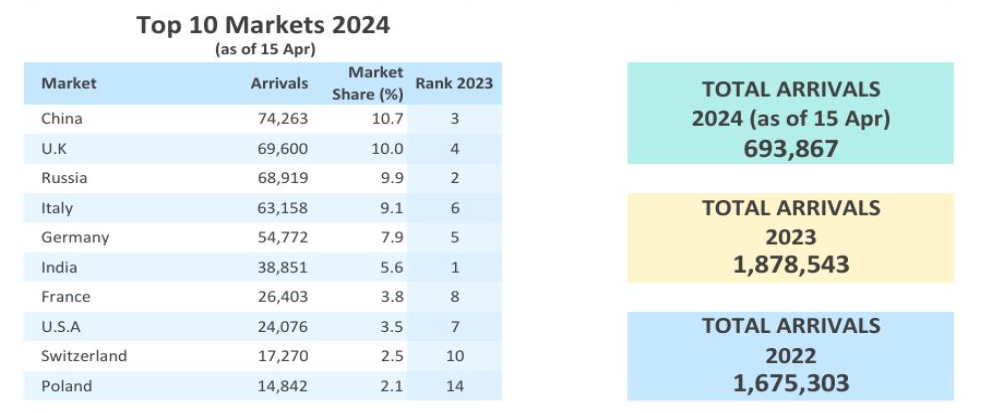
Maldives has so far received (from January 1-April 15) 693,867 tourists, up from 606,395 arrivals for the same period last year, as per the latest data from the Maldives tourism ministry.
China is the top source market for the island destination, followed by UK and Russia.
Between January 1-April 15, almost 39,000 Indians visited Maldives, a decline of almost 40%, compared to the 64,250 arrivals for the same period last year.
“We might not talk immediately about the growth scenario, but I would definitely like to see the 40% decline narrow down,” Ghiyas said.
Can’t Ignore India
While Maldives has experienced record-breaking tourism arrivals so far, Ghiyas said it still needs India. “There are properties and resorts that rely heavily on the Indian market, which have been severely affected. This will hurt us in the long term and that is why we have decided to engage with the India market.”
Aminath Suzan, CEO of Maldives Association of Travel Agents and Tour Operators, pointed to cultural ties, such as similarities in food, language, and pop culture. “We must ensure that unrelated matters do not negatively impact the bond, for which we have dedicated years and built this alliance.”
MATATO Meets with Indian High Commissioner to Foster Tourism Cooperation The Maldives Association of Travel Agents and Tour Operators (MATATO) engaged in a productive meeting with His Excellency Munu Mahawar, the Indian High Commissioner to the Maldives, to explore collaborative… pic.twitter.com/PNXiy3QdVz — MATATO – PATA Maldives Chapter (@matatoMV) April 9, 2024
The association members also recently met with Munu Mahawar, the Indian high commissioner in Maldives, to collaborate closely with his office to boost tourism initiatives.
Dubbing the meeting with Mahawar “positive,” Ghiyas said the high commission has offered assistance to the association. “Once we have a concrete plan, we will definitely follow up with the High Commission and share our plans.”
Skift India Report
The Skift India Report is your go-to newsletter for all news related to travel, tourism, airlines, and hospitality in India.
Have a confidential tip for Skift? Get in touch
Tags: asia monthly , china , india outbound , islands , maldives , social media , tourism marketing
Photo credit: Ritz Carlton Maldives Fari Islands. Fari Islands
- International edition
- Australia edition
- Europe edition

Coral bleaching spreads to Maldives, devastating spectacular reefs
Exclusive : Images from the Indian Ocean archipelago reveal the extent of the longest global coral bleaching event in history
Coral bleaching in the Maldives – in pictures
The longest global coral bleaching event in history is now devastating reefs in the crystal clear waters of the Maldives , with images released exclusively to the Guardian powerfully illustrating the extent of the damage there.
Photographed by the XL Catlin Seaview Survey, the images captured the event in May as it moved beyond the now devastated Great Barrier Reef and into waters further west.
“The bleaching we just witnessed in the Maldives was truly haunting,” said Richard Vevers, founder of the Ocean Agency.
“It’s rare to see reefs bleach quite so spectacularly. These were healthy reefs in crystal clear water at the height of an intense bleaching event. The flesh of the corals had turned clear and we were seeing the skeletons of the animals glowing white for as far as the eye could see – it was a beautiful, yet deeply disturbing sight.”
The Maldives is series of coral atolls, built from the remains of coral. The livelihoods of people there depend on the reefs through tourism, fisheries and as a wave-break that helps prevent inundation on low-lying islands.
The photographs were part of an ongoing project , in partnership with Google, the University of Queensland and the US National Oceanic and Atmospheric Agency to capture the global bleaching event as it moves around the world.
“We’ve been following this third global bleaching event since the start nearly two years ago and just when you think you’ve seen the saddest sight you’ll ever see, you see something even worse,” Vevers said.
The event started in mid 2014 in the Pacific Ocean around Hawaii, which then got hit again in 2015. In early 2016 it spread to the Great Barrier Reef where 93% of its nearly 3,000 reefs were hit by bleaching.
Western Australia’s reefs in the Indian Ocean have also experienced severe bleaching .

When Noaa declared the event was a global bleaching event in October 2015, Mark Eakin, Noaa’s Coral Reef Watch coordinator, said it could last well into 2016. That prediction appears to be proving correct.
“The current global bleaching event is already lasted longer than any previous bleaching event and is likely to last until at least the end of the year,” he said.
The bleaching event started with an El Niño that appeared to be developing in Pacific Ocean, in 2014, warming the waters there, but which failed to eventuate. It was then combined with a large patch of unusually warm water, nicknamed “the blob”, that lurked around the Pacific, as well as an extreme El Niño that eventually did develop in 2015.
Extreme El Niños, which spread warm water across the Pacific and warm the globe, were not seen before 1982 and have occurred three times since. Extreme El Niños are expected to increase in frequency as a result of climate change.
Those El Niños were also occurring in an ocean where the surface has already warmed by 1C, putting corals near their thermal limits.
When coral sits in water that is too warm for too long, it gets stressed and expels the algae that provides it with about 90% of its energy. If it stays stressed for more than a couple of weeks it starts to starve, become diseased, and dies.
A new study has found the conditions that led to the devastating bleaching on the Great Barrier Reef were made 175 times more likely by climate change, and on the current trajectory, would become the average conditions by the 2030s.
- Climate crisis
- El Niño southern oscillation
- Marine life
- Great Barrier Reef
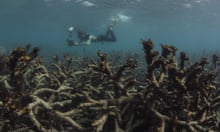
Five things we can do right now to save the Great Barrier Reef
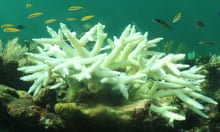
‘Unprecedented mass coral bleaching’ expected in 2024, says expert

The Great Barrier Reef: a catastrophe laid bare

The scientist who was branded alarmist for exposing the fate of coral reefs

Reefs made from trees could help restore biodiversity, study finds

Coalition will protect Great Barrier Reef with $1bn fund, says PM

‘Coral are going to die’: Maui wildfires take toxic toll on marine ecology

Coral bleaching: 'We need to tell the truth without scaring reef tourists away' – video

The Guardian view on protecting corals: what lies beneath matters too

Government rules out public funds for Adani coal project, activists claim
Comments (…), most viewed.
- Tata Steel share price
- 165.85 -1.04%
- Kotak Mahindra Bank share price
- 1,608.40 -2.11%
- Wipro share price
- 464.65 0.79%
- ITC share price
- 439.95 0.56%
- Tech Mahindra share price
- 1,277.45 7.34%
Indian tourists ditch Maldives amid row as numbers drop 40%; China arrivals up 200%
A report by the maldives' ministry of tourism showed that as many as 56,208 indian tourists had visited maldives between january and march 2023. this number declined to 34,847 in the january-march 2024 period..

The number of tourists from India to the Maldives declined by almost 40 per cent during the January-March 2024 period as compared to the data from the same period in 2023. At the same time, the total number of tourists from China shot up by over 200 per cent.
The Maldives' Ministry of Tourism released its monthly report on tourist arrivals recently. The data showed the tourist arrivals in the island nation between January and March this year.
ALSO READ: How did China strengthen its bond with Maldives amid India exit? 10 key collaborations between Male, Beijing
The report revealed that as many as 56,208 Indian tourists had visited Maldives between January and March 2023. This number declined to 34,847 in the January-March 2024 period. This was a 38 per cent decline from 2023.
Meanwhile, 17,691 tourists from China visited Maldives during January-March 2023. The tally rose to 67,399 during January-March 2024 — recording a spike of 281 per cent.
ALSO READ: Maldives snubs India over hydrographic survey deal after signing military pact with China
As per the latest data, India ranks sixth in the top 10 markets for Maldives tourism, while China ranks No. 1 with an 11 per cent share.
The data holds significance as India once used to be a significant and top-most contributor to the Maldive's tourism statistics. Indians were only second to Russia in the chart showing tourist arrivals in the Maldives by nationality in January-November 2023. The increase in arrivals from India started in 2020, as compared to that from China.
Before 2020, people from China were leading the tourism charts in the Maldives. In 2020, China had an 18.31 per cent share among ‘Top Ten Markets Arrivals’ in Maldives, the highest that year.
India dominated the Maldives tourism market until December last year. Its position started declining starting January 2 this year, when India ranked third among the top 10 countries that make up most of the Maldives' tourism market share. India's rank further plunged to fifth on January 21 and then to sixth on March 3.
Since then , China has steadily climbed the chart from 10th to the first spot.
India-Maldives row
The drop in tourists from India was seen soon after Prime Minister Narendra Modi attempted to promote Laskhwadeep as a tourist destination, triggering a row in the Maldives in the first week of January this year. Later, Maldives' President Mohamed Muizzu requested India to withdraw its troops stationed in the island nation.
The declining number of tourists from India and the subsequent increase in that from China is in line with Muizzu's policies and deals that seem to snub India and welcome China.
Milestone Alert! Livemint tops charts as the fastest growing news website in the world 🌏 Click here to know more.
Unlock a world of Benefits! From insightful newsletters to real-time stock tracking, breaking news and a personalized newsfeed – it's all here, just a click away! Login Now!
Wait for it…
Log in to our website to save your bookmarks. It'll just take a moment.
You are just one step away from creating your watchlist!
Oops! Looks like you have exceeded the limit to bookmark the image. Remove some to bookmark this image.
Your session has expired, please login again.
Congratulations!
You are now subscribed to our newsletters. In case you can’t find any email from our side, please check the spam folder.

Subscribe to continue
This is a subscriber only feature Subscribe Now to get daily updates on WhatsApp

COMMENTS
The Maldives is a tropical paradise of immaculate white beaches and spectacular coral reefs - but it might be gone by the end of the century. That's the verdict of the country's Minister of ...
The scheme will reportedly cost $147.1m (£117m) and be funded via an Indian bank. According to Van Oord, up to 5m cubic metres of sand will be dredged from a lagoon in the middle of the six ...
The Maldives is an 820-kilometre-long chain of nearly 1,200 islands dotting the Indian Ocean. The nation has become one of the most popular luxury tourism destinations in the world because of its ...
Strong recovery in tourism was highlighted in the latest edition of the World Bank's Maldives Development Update (MDU), which analyses recent developments and presents an outlook on the Maldivian economy. It finds that while the Maldives economy recovered sharply and external imbalances improved in 2021, the outlook remains uncertain given travel and commodity price concerns.
The Maldives is one of the most popular luxury tourism destinations, with the government marketing it as "the sunny side of life" to a global audience. ... In addition to the disputed economics, there is serious concern about the environmental damage that land reclamation can cause. Studies in the Maldives and at other sites around the ...
An estimated 860 tonnes of solid waste is discarded daily in the Maldives, with around 21% due to tourism. Plastic makes up a significant proportion of this waste. Plastic makes up a significant ...
With about 25 of the Maldives' 166 resorts still closed, overall national visitor numbers are still down on pre-pandemic levels but they rose steeply in the second half of the year. In August ...
Plastic waste. An estimated 860 tons of solid waste is discarded daily in the Maldives, with around 21% due to tourism. Plastic makes up a significant proportion of this waste. Every day, plastic ...
Maldives' tourism looking up after reopening. Despite challenges faced during the year, the Maldives welcomed a total of 555,494 international tourists in 2020. In January 2021, arrival numbers stood at 92,103 and it increased to 99,397 by 3rd February 2021 with a daily average of 2,923 tourists.
Facing dire sea level rise threat, Maldives turns to climate change solutions to survive. The islands could be 80% uninhabitable by 2050 at current global warming rates. By Daniel Manzo, Ginger ...
Courtesy One&Only. Thoyyib Mohamed is the managing director of the Maldives Marketing & PR Corporation, the country's national tourism authority. He says that the country received a total number ...
The Maldives' rapid rise to becoming a top travel bucket list destination unfolded only over the past 50 years - with no signs of slowing down. International tourism accounts for 58.3% of the ...
To ensure tourism and economic operations can continue in spite of climate changes, The Maldives Ministry of Tourism launched the Tourism Adaptation Project. This joint venture between public and private sectors seeks to mitigate the impacts of rising sea levels and temperatures through a myriad of operational enhancements and alterations.
Coral reefs are vital to the Maldives. This is how travelers can help restore them. The coral fragment from the seafloor off the coast of the resort Siyam World Maldives in the Noonu Atoll had a ...
Maldives's exclusive economic zone (EEZ) consists of only 1% land across 1,192 small islands and 99% sea, comprising the world's seventh largest reef system. The seas teeming with marine flora and fauna, white sandy beaches, and year-round warm weather make the country a leading tourist destination. However, these very elements are also compounding factors in Maldives' extreme ...
It then came as some surprise when the Maldives released their tourism figures this week, revealing a 17 per cent global rise in the number of arrivals in the first three months of 2018. British ...
The Maldives was the only country where the effects of the tsunami were felt across the country, rather than in certain parts or regions. Total damage estimates are about $470 million. Of the 198 ...
There are roughly 200 inhabited local islands in the Maldives, including Malé, the densely-populated capital. Around 166 are resort islands, with 29 more islands allocated for development in 2019 and 14 more in 2023. Tourism leases can last 100 years, so these are long term developments. The enormous whale sharks, gentle giants, are one of the ...
Source: Ministry of Tourism, Maldives. Maldives has so far received (from January 1-April 15) 693,867 tourists, up from 606,395 arrivals for the same period last year, as per the latest data from ...
The Maldives is series of coral atolls, built from the remains of coral. The livelihoods of people there depend on the reefs through tourism, fisheries and as a wave-break that helps prevent ...
Maldives Tourism industry in damage control mode, says "strongly condemn" derogatory comments by its ministers towards Indian PM Modi 'India has also been a consistent and significant contributor to the Tourism Industry of Maldives. A contributor that has greatly assisted our recovery efforts during Covid, right after we re-opened our ...
MALDIVES TOURISM UPDATES 23rd December 2021 Vol - 50 1. Tourist Arrivals From 1st January 2021 to 22nd December 2021, a total of 1,271,020 tourists arrived in the Maldives. The top five markets during this period were India, Russia , Germany, United Kingdom and U.S.A. Total Arrivals 2020 555,494 as at end December 2020 Total Arrivals 2019 ...
An island resort in the Maldives Diamonds Thudufushi Beach & Water Villas, a luxury resort on Thudufushi, Ari Atoll in May 2017 Tourism Zone. Tourism is the largest economic industry in the Maldives, as it plays an important role in earning foreign exchange revenues and employing 25,000 people in the tertiary sector of the country. The archipelago of the Maldives is the main source of ...
Given the importance of tourism to the Maldives, this Action Plan is designed to guide a tourism-specific response to many climate-induced challenges while providing more business-targeted guidance in support of Goal 4—Build Climate Resilience and Protect Natural Assets—of the Maldives Fifth Tourism Master Plan.
A report by the Maldives' Ministry of Tourism showed that as many as 56,208 Indian tourists had visited Maldives between January and March 2023. This number declined to 34,847 in the January-March ...
According to the Maldives Tourism Ministry statistics, over 17 lakh tourists visited the island nation in 2023, out of which more than 2,09,198 visitors were Indians followed by Russians (2,09,146) and China (1,87,118). The number of Indian visitors was more than 2.4 lakh in 2022 while over 2.11 lakh Indians flew to the Maldives in 2021.